It’s your biggest frustration.
The thing that keeps you up at night. That makes you want to bang your head against the wall over, and over, and over...
Not enough traffic.
You can learn every conversion technique in the world but it will all be pointless if you have nobody to convert. So how do you fix the traffic drought?
Maybe you've tried a million things and they don't seem to work. Or maybe you read our guide 130 Ways to Get More Traffic to Your Website and didn't know where to start.
Well, You don’t have to look any further than the social platform you won’t admit you still use:
Facebook.
With this one social platform alone, you'll be able to skyrocket your traffic, and get your content and business in front of the eyes of hyper-targeted groups of your ideal customer. For free.
I hope you have your party pants on, because this is the ONLY guide you'll ever need to read to drive MASSIVE free traffic and results from Facebook. Seriously. Ready?
Why Facebook for Traffic?
Facebook remains the biggest social network in the world bar none, with over 1.5 billion monthly active users.
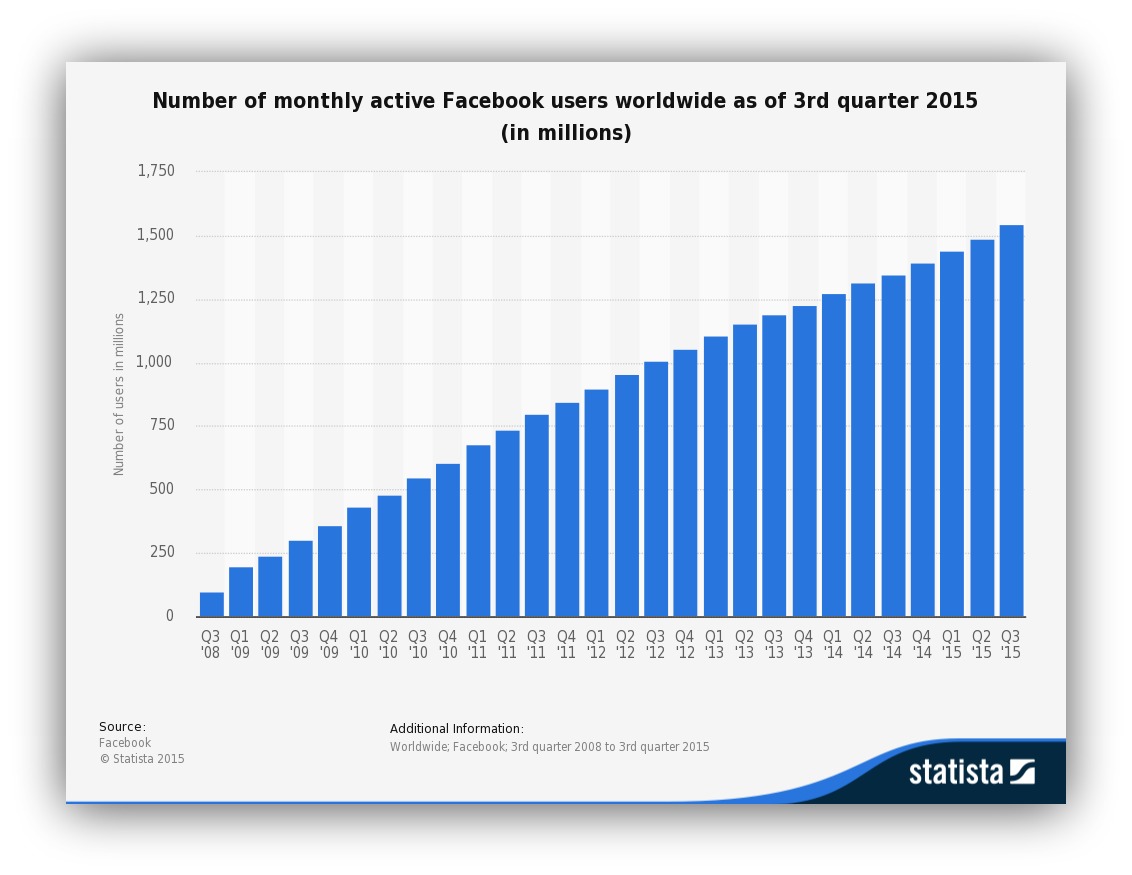
With those numbers, it’s tough to argue that your target market is not on Facebook.
If you’re not convinced yet, a report from Shareaholic shows that as of October 2014, Facebook drove almost 25% of all web traffic.
Open your Google Analytics. Is 25% of your traffic coming from Facebook? No? Then you're leaving free visitors on the table and need to read this.
After you read this article, you’ll be equipped with Facebook traffic knowledge bombs to take you past the limited reach your Facebook page is currently getting and start rolling in Facebook traffic goodness.
This truly is a Sumo-Sized guide, clocking in at over 10,000 words. Yep, you read that right. That's why we created a checklist to help you through EVERY strategy in this guide, step-by-step, so you don't get lost in the weeds:
Click here for our Facebook traffic checklist!
So now that you've got your party pants on and you're armed with the checklist, here’s what we’re going to cover:
- Increase Shares by Making Your Content MASSIVELY Share-Worthy
- Drive Traffic by Starting a Facebook Group
- Boost Your Visitors by Participating in Established Facebook Groups
- Get More Facebook Fans for Wider Reach
- Maximize the Reach (and Traffic) from Your Facebook Page
- Push Traffic by Reviving Your Archives
- Optimize Your Personal Facebook Profile for Traffic
As you’re reading, remember that the roadmap for traffic from Facebook looks like this:
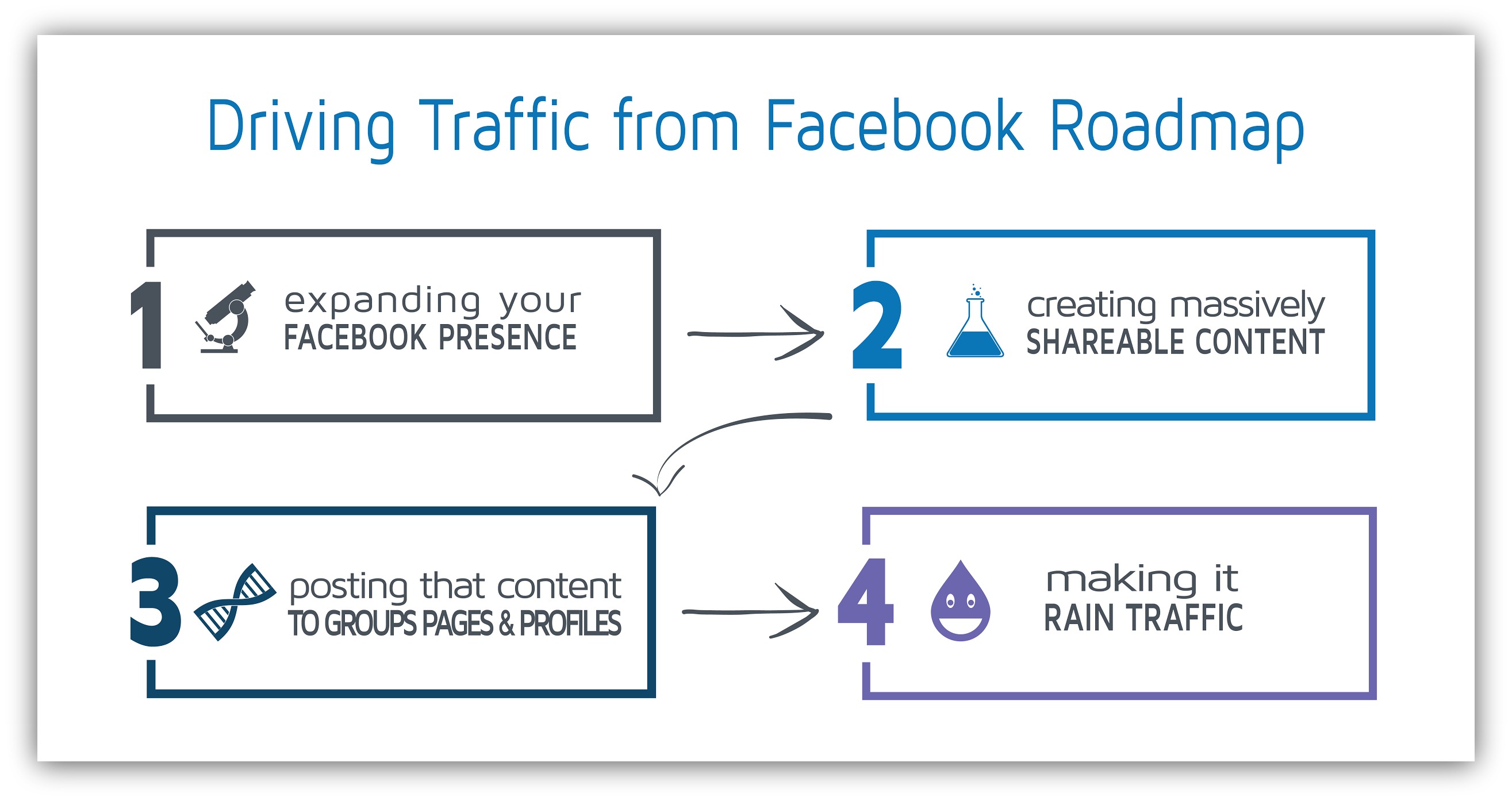
Without one of the directions on the roadmap, you’ll get lost in an empty, trafficless void. You don’t have to take all of the strategies in this guide to get to the coveted #4, but don’t skip over any of the steps in the roadmap.
Choose one (or more) of these tactics to drive traffic to your website through Facebook.
Strategy #1: Increase Shares by Making Your Content MASSIVELY Share-worthy
You know what helps you get more traffic from Facebook?
People sharing your content on Facebook with their friends. And their friends sharing it with their friends. And…
You get the point.
Think about it. If even 10 people visit your website each day, and one of those people share your content with 200 friends on Facebook, you’d boost your Facebook traffic. And if even two of those 200 friends (that’s just 1%!) shared it with their 200 friends…
It’s the domino effect in action. But how do you push over the first domino and get that first person to share your content?
Well, you need to create content that acts as share magnets. I’ll show you how.
Trigger High-Arousal Emotion
If you want to create content that is crazy-shareable - content that has the potential for going viral on Facebook and other social channels - you’ve gotta inject some emotion.
I’m not suggesting you make your visitors want to cry. I am suggesting that you get your users fired up about something, though.
In the book Contagious: Why Things Catch On Jonah Berger conducted a study to analyze virality - or why things go viral on the interwebz.
The study proved that content that triggers “high arousal emotion” (like anxiety and amusement) is far more shareable than content that elicits either no emotion or “low arousal” emotion.
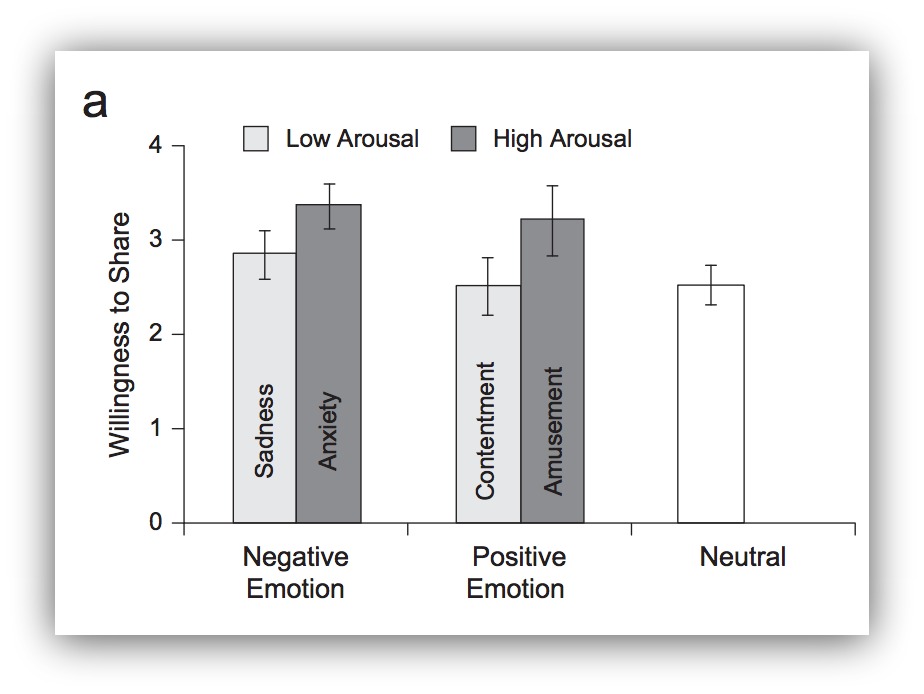
Those who felt “fired up” were more likely to say they would share the content than those who felt mellow or neutral.
Why do you think that every time you log in to Facebook you see yet another Buzzfeed “article”?:
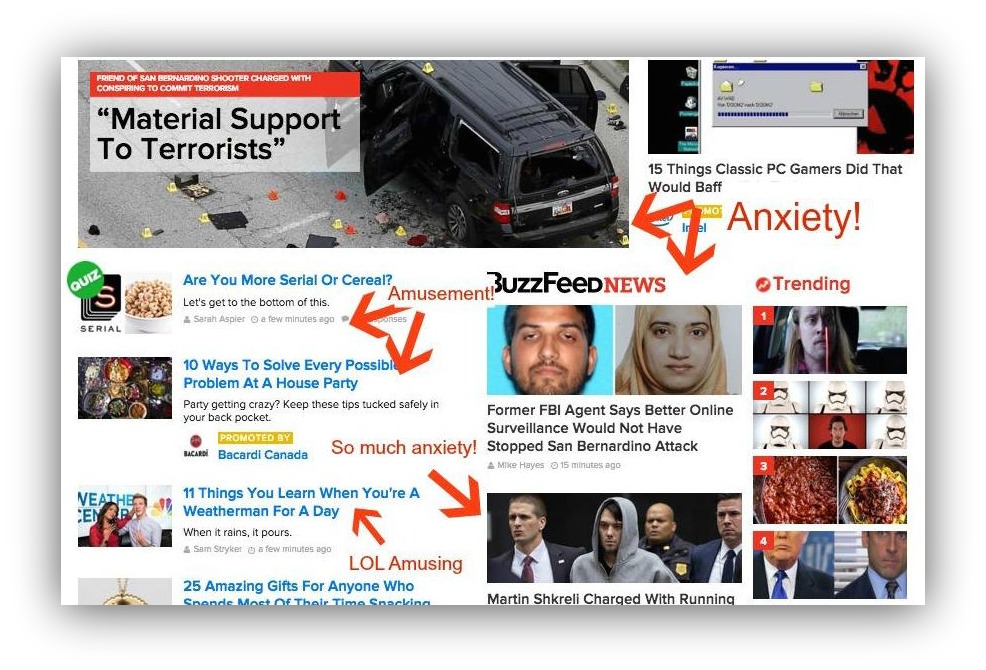
If you can entertain your visitors or trigger some good old-fashioned anxiety, you’re on your way to conquering Facebook.
Include emotional triggers to elicit emotions like fear, outrage, awe and amusement in your headlines, calls to action, and content itself to increase those shares - and therefore, traffic.
Use a Strong Call to Action
You know what works best when you want something from somebody?
Asking them for it.
In fact, it works far better than expecting them to read your mind (surprising, right?).
That’s why using a strong call to action works so well. Derek Halpern nails this with his video Why People Don’t Buy What You Sell. Which are you more likely to share - the example on the left or the example on the right?
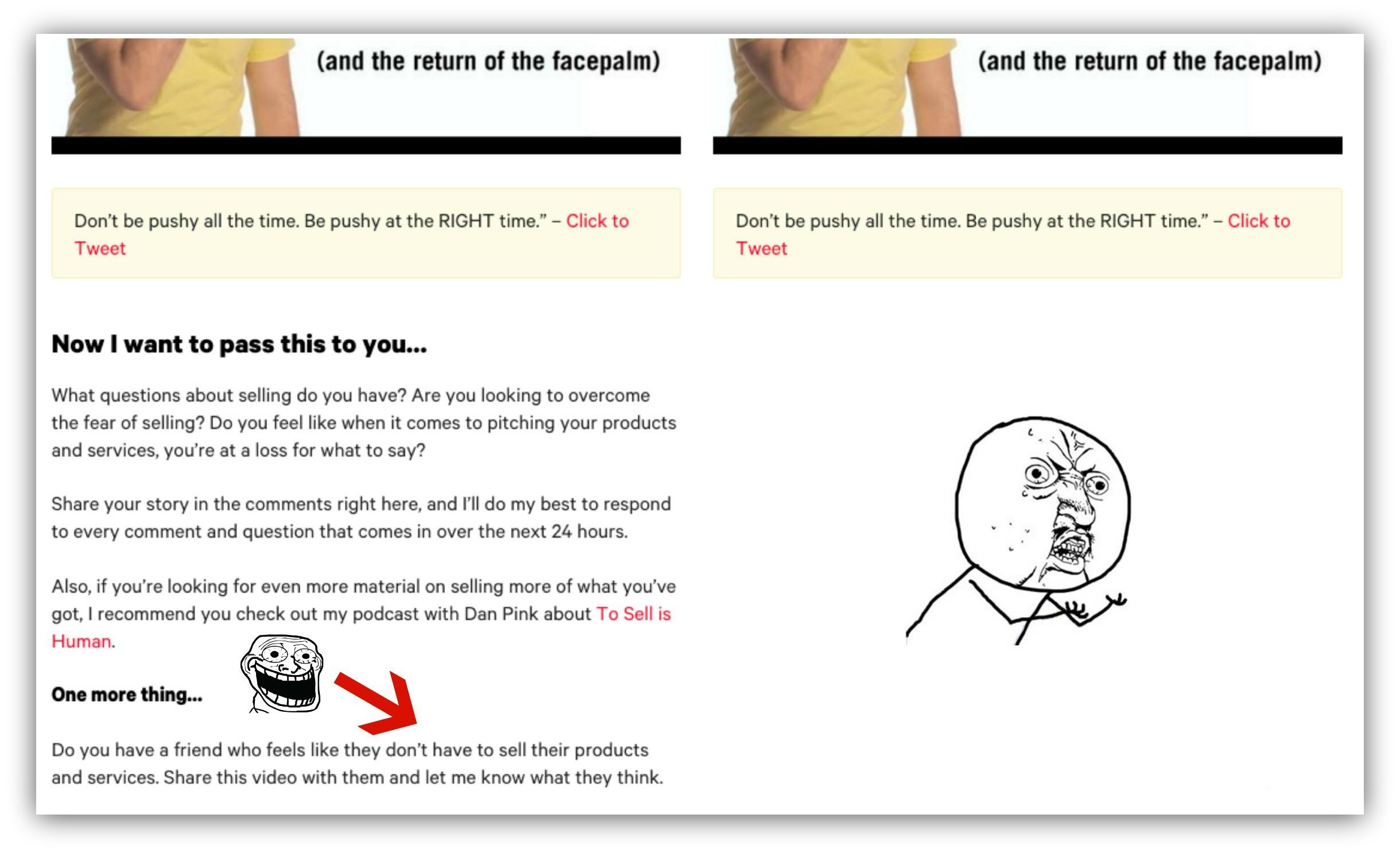
That’s what I thought.
Increase your shares by actually asking your existing visitors to share your content.
Don’t just ask them for the share, though. Get as specific as possible and watch your shares (and traffic) skyrocket. Ask them to share with a friend who would appreciate the content, or for a specific reward...
Incentivized Sharing for Super-Effectiveness
To boost your Facebook shares and therefore traffic, try incentivizing the sharing.
We did this in our 2016 Reading List, offering a free book set to one winner who shared:
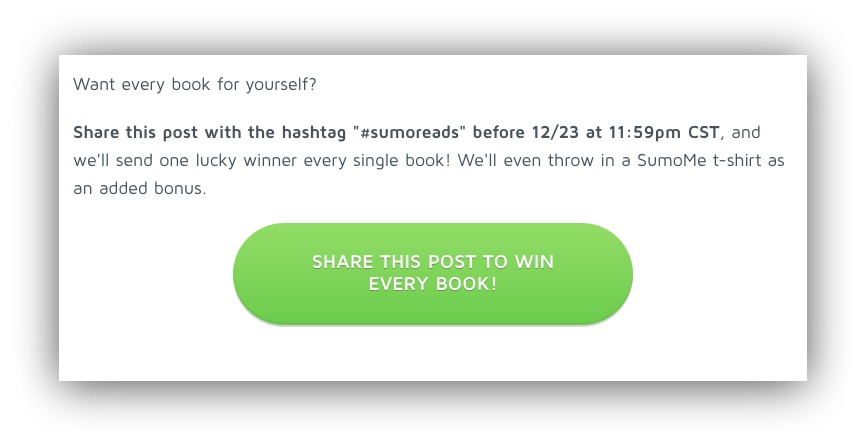
And also in our Power Words guide by offering a bonus spreadsheet to sharers:
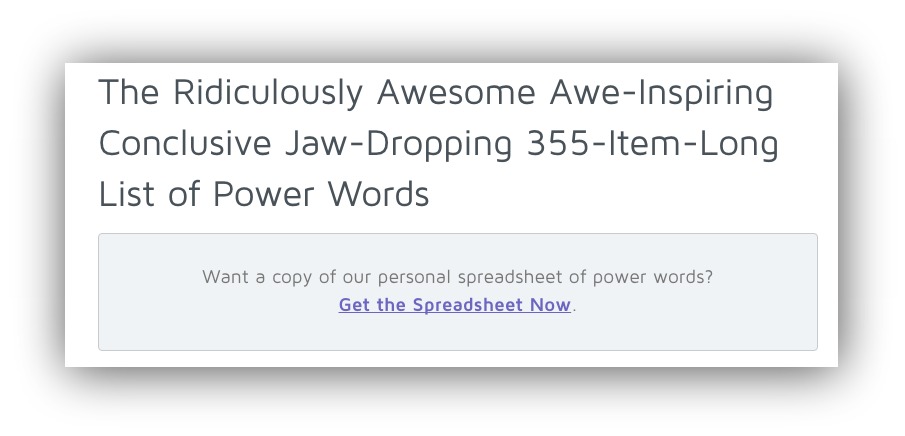
When you click the “Get the Spreadsheet Now” button, it’s yours for free if you share the article, boosting our social shares.
Use Power Words
Remember when we told you that power words crank up your marketing effectiveness?
This remains true for making your content more shareable on Facebook, too. Using power words not only drives traffic to your content when it is shared, but it also makes people want to share it.
Take a page from Cosmo (get it?) and weave power words into your headlines:
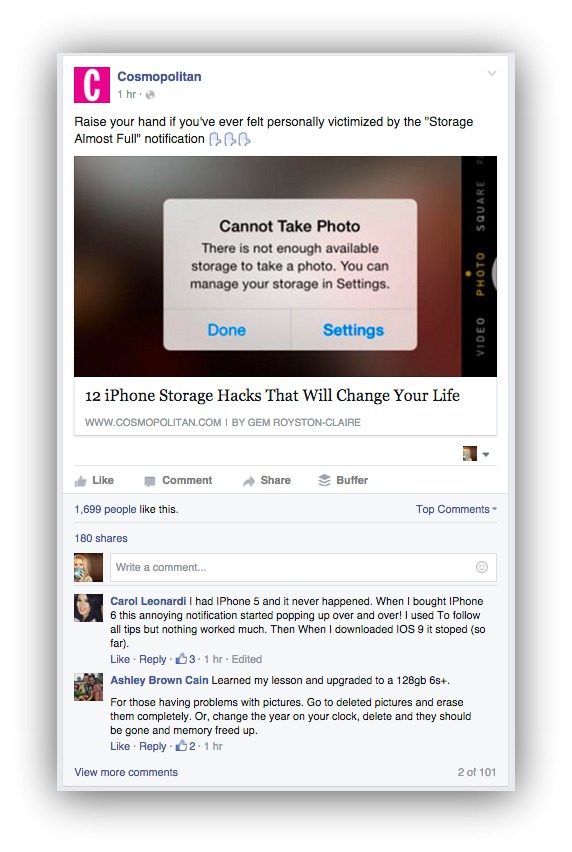
Which would you rather share:
12 iPhone Storage Hacks That Will Change Your Life
or
12 Ways to Increase Your iPhone Storage?
I want to be responsible for changing my friend’s lives, not being a Practical Patty with iPhone storage.
You can choose from a list of 355 power words here.
Make it Dead-Simple to Share
The lowest hanging fruit for amping up your traffic from Facebook is making sure your content is easy to share for your existing visitors.
Regrettably, your audience has the attention span of a goldfish - meaning they’re not going to do any of the ground work to share your content themselves.
You have to make it dead simple for them to do so.
This article on power words was shared over 300 times on Facebook, driving a lot more traffic to the post:
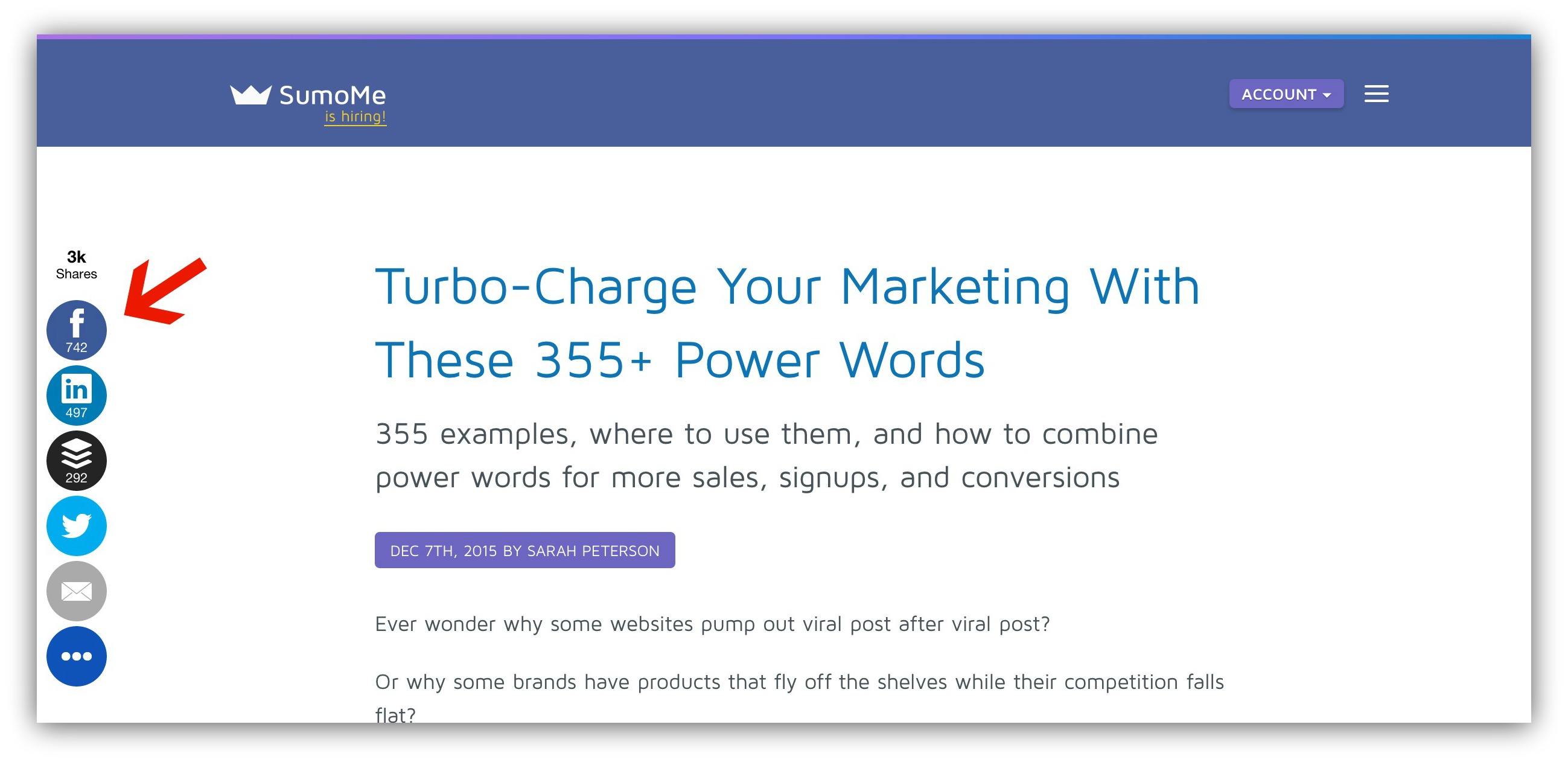
But what if we didn’t have those share buttons floating to the left of the post?
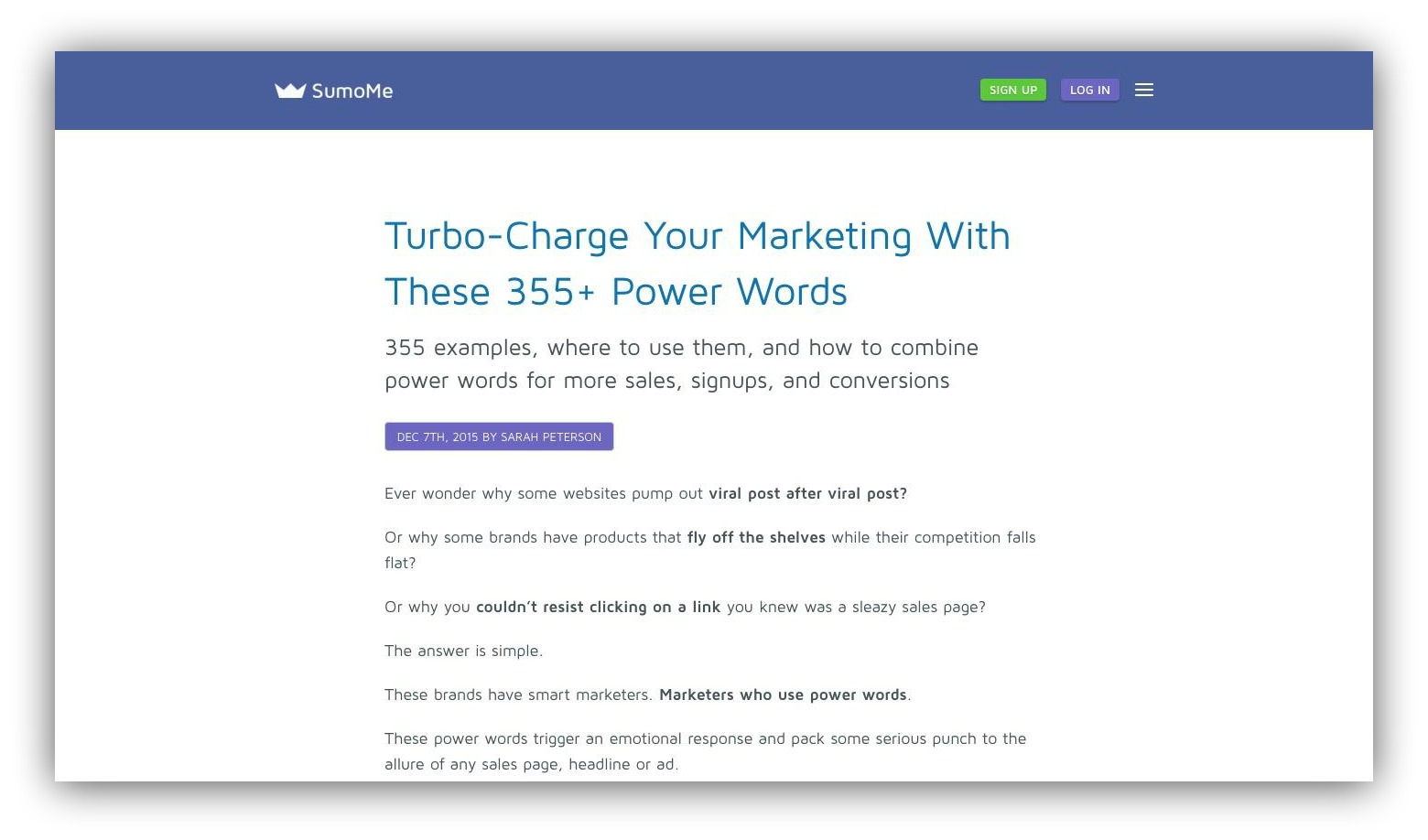
We would have been giving up thousands of views because it would have been much more difficult for readers to share it. Here is our traffic for that article on the day it was published.
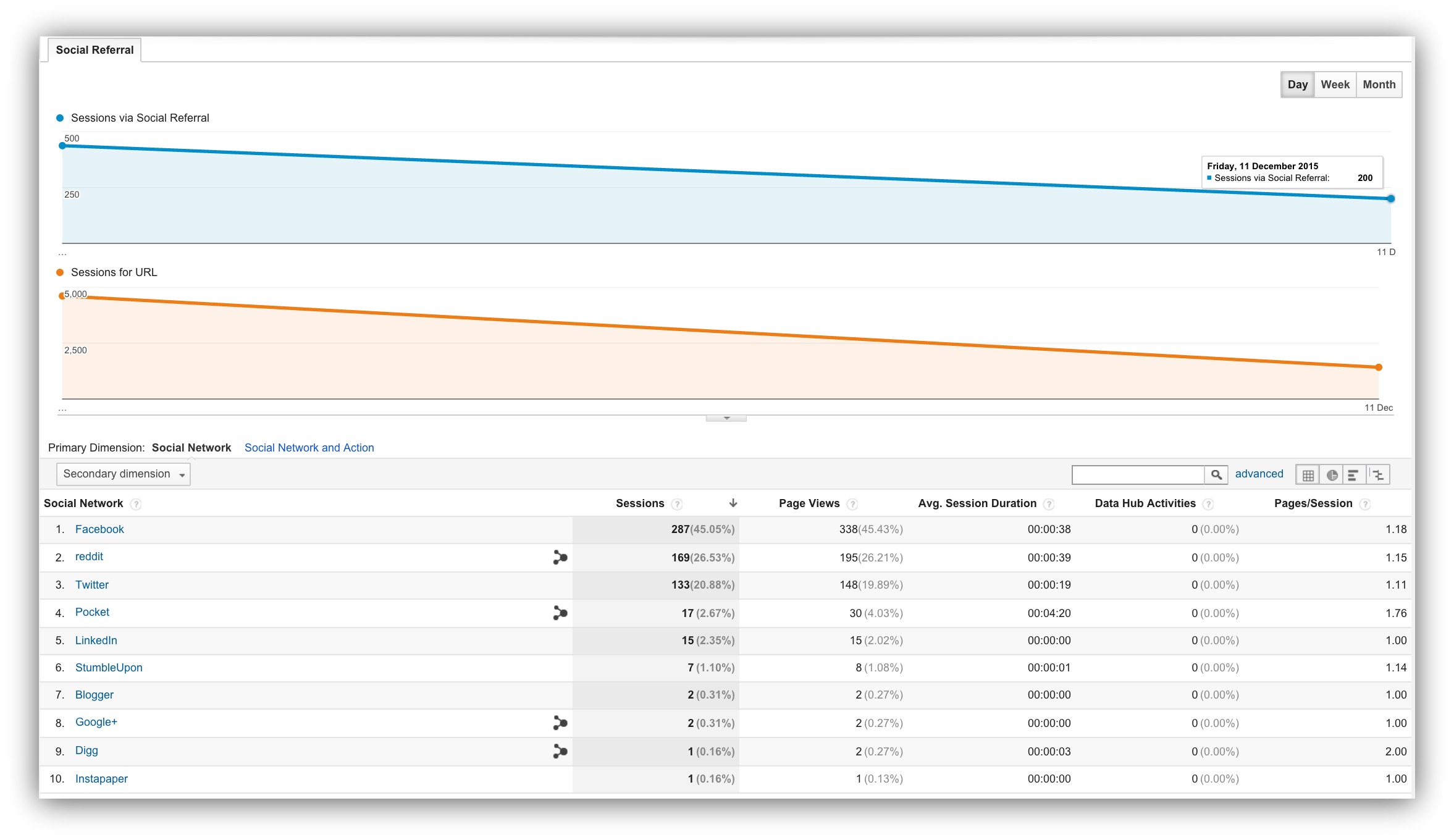
If you haven’t already (seriously, bro?), install Sumo and activate the Share buttons. Don’t make your visitors hunt for a way to share your content - because they won’t.
Create Beautiful, Shareable Images
When people share your content to Facebook, you want the resulting post to be eye-catching and visually appealing to entice their friends to click the link.
To boost those shares, clicks, and engagement, create a custom image for your content like we’ve done with our social proof post:
Airbnb, Slack, Amazon, and every other top site uses this tactic. Are you taking full advantage of it?
Posted by Sumo.com on Thursday, December 17, 2015
You don’t have to be a designer to create shareable images. You have a couple of options:
- Use a program like WordSwag, Canva, or PicMonkey to include text over an image. WordSwag is by far the easiest, as it pulls free, high quality images from Pixabay.com which don’t require attribution.
- If you want to get fancy and can find your way around Adobe Photoshop or Illustrator, you can flex your branding muscle. Use the fronts your brand usually uses and use images from a stock photo service like Bigstock.
When you create your images, make sure they fit within the ideal Facebook image sizes to ensure it displays nicely:
- Landscape: 1200 x 628 pixels (ideal)
- Square: 470 x 470 pixels
- Portrait: 500 x 700 pixels
After you create this shareable image, set it as the meta image so when people share it to their own news feeds, you’re increasing the chances that their friends will actually click on the article, and then share it themselves.
To make sure the correct image shows up on Facebook when the content is shared, you can either get complicated and add “open graph” tags to your section of every page on your website, or just keep it simple and install a plugin that will let you set the meta image, like Yoast SEO Plugin.
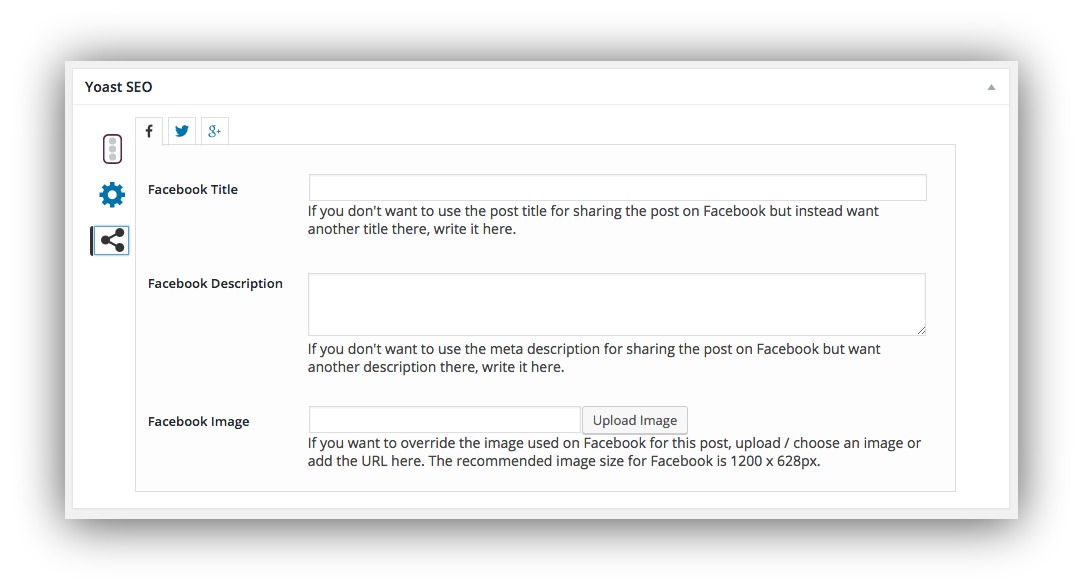
With this plugin you can also set meta descriptions and titles just for Facebook (the perfect place to incorporate those power words).
After you’ve made your content incredibly shareable, you can check that off the list and move to the next item…
Starting a Facebook group.
Strategy #2: Drive Traffic by Starting a Facebook Group
One of the most lucrative ways to not only increase your Facebook traffic but also engagement with your audience is through Facebook groups.
Facebook groups are ripe opportunities for market research and traffic back to your website because you’re putting your content in front of the eyes of your audience where they spend time: their news feeds.
This makes groups one of the best ways to use Facebook for marketing right now. And guess what? You’re about to see a little piece of Sumo history go down, because we’re starting a Facebook group for our Sumo Pro users in public to demonstrate.

So how do you start a group to drive traffic back to your site? First, you have to decide on the position of your Facebook group.
How to Position Your Facebook Group
You can either position your Facebook group around:
1. An event, challenge, or course you run
2. Your website/business in general
3. Your niche, industry, or topic.
There are pros and cons to each, so before you choose, ask yourself what your objective for your Facebook group is.
Do you want to drive new visitors to your website? If so, focus on the third option. Do you want to maximize your relationship with your existing fans and drive repeat traffic to your website? If this is your jam, focus on the first two.
Positioning Your Group Around an Event
Let’s say you are in the fitness industry and decide to host a 100 pushup challenge. Every day for a month you challenge your followers to do 100 pushups.
You could start a Facebook group for the members of the challenge for accountability, support and community.
Then, to drive traffic back to your site - because that’s what this is all about, isn't it? - post the resources you’ve created to help your members successfully complete the challenge. Maybe you have videos or articles about the perfect pushup form, or habit-building resources to help them through the challenge.
An example is the raw food recipe website Young and Raw, which runs a green smoothie challenge regularly for their audience:
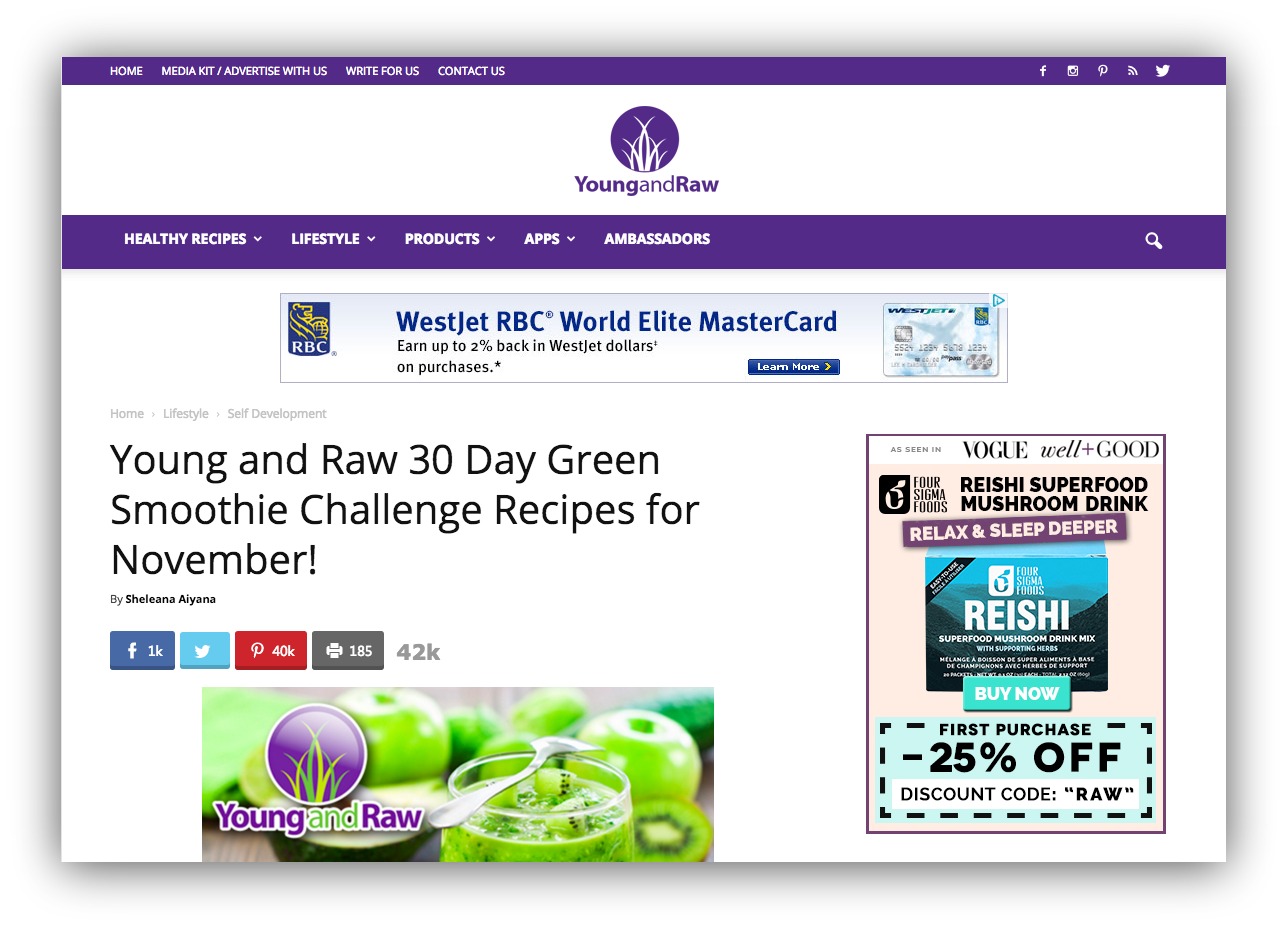
And they have a Facebook group for the members of the challenge, with over 37,000 members.
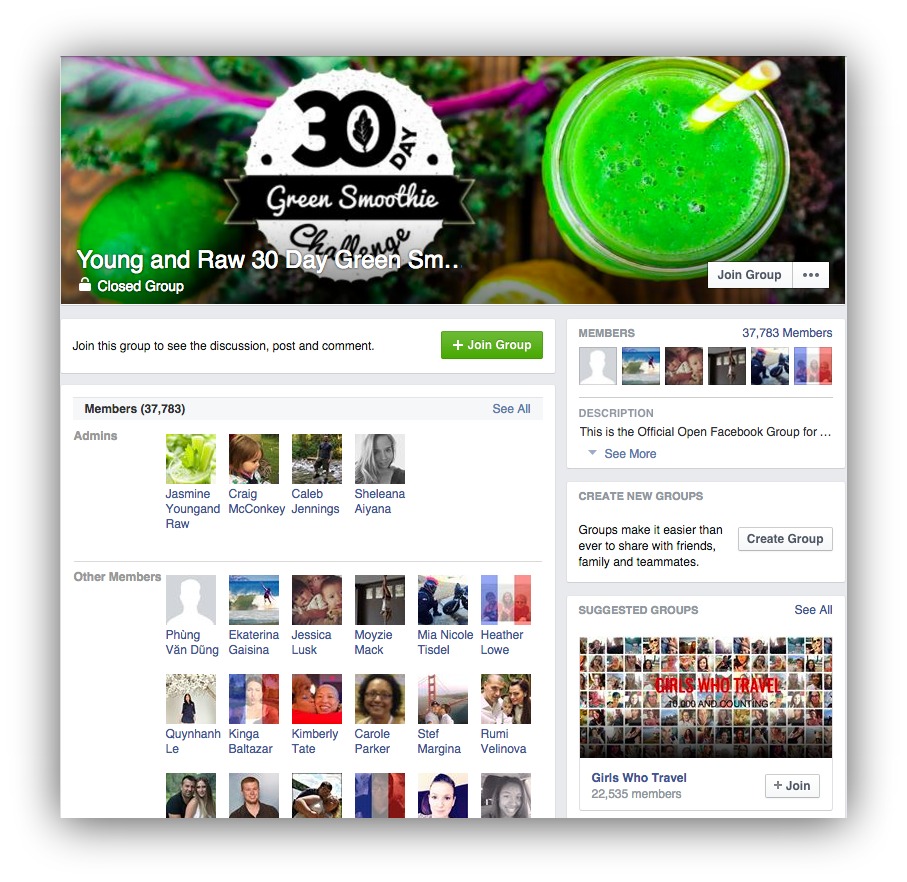
You can bet that when they have a new recipe to add to the challenge or a new blog post to share, they get a ton of traffic after posting in their group.
One limitation of this type of positioning is that it doesn't make much sense to share all of your content in this group. Instead, stick to sharing only content related to the specific event.
Positioning Your Group Around Your Business/Website
Opening a group around your brand allows members to get to know each other and build community.
An example of somebody who has done this is Kimra Luna, a personal branding and online business strategist:

If you want to create a group with thousands of members, this might limit you. Usually only those who are already fans will join groups based around your business, so you won’t get new fans, but rather foster a deeper relationship with your existing fans.
Your relationship with your existing fans is crucial for driving traffic (not to mention sales) so don’t write this option off. We’re taking this route with our shiny new Sumo group.
Position Your Group Around Your Industry
If you want to reach a whole new audience through your Facebook group, and drive new visitors to your website through posting your content, this is the way to go.
This type of group is separate from your brand entirely and instead is around your industry or topic. This might limit the amount of engagement you have in your group (and interest in the content you post) but you’ll grow the group a lot faster, full of targeted leads.
There’s no right or wrong answer with how to position your Facebook group. Just get crystal clear on your objectives.
Once you’ve decided how you want to position group, the next step is easy:
Creating Your Facebook Group
Actually creating the group in Facebook is a simple process. Under the downward arrow at the top left-hand corner of your personal Facebook profile page, you’ll see a “Create Group” button.
You can’t create a group from your Facebook page.
When you’ve selected “Create Group”, you’ll see this pop-up:
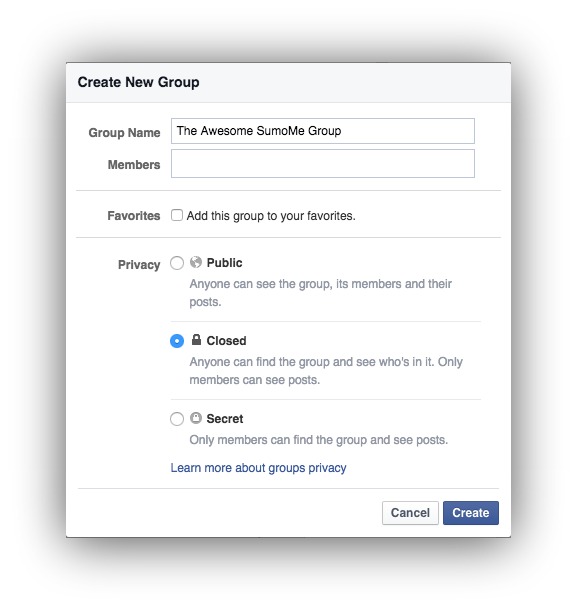
- Name your group: What would people who are searching for your Facebook group type into the search bar? Don’t try to be too clever and choose a witty name. Include keywords and search terms, even if your group is specific to your brand.
We called the Sume group Sumo Site Growth Mastermind (site growth being the keyword).
- Members: You have to add at least one member to begin with. You can always remove them later.
- Privacy: Closed groups are by far the best. Public groups are a spam-magnet, and nobody can find secret groups. Closed groups make members feel protected and free to make connections while still being searchable.
Once you’ve pressed the “Create” button, you’ll come to this screen:
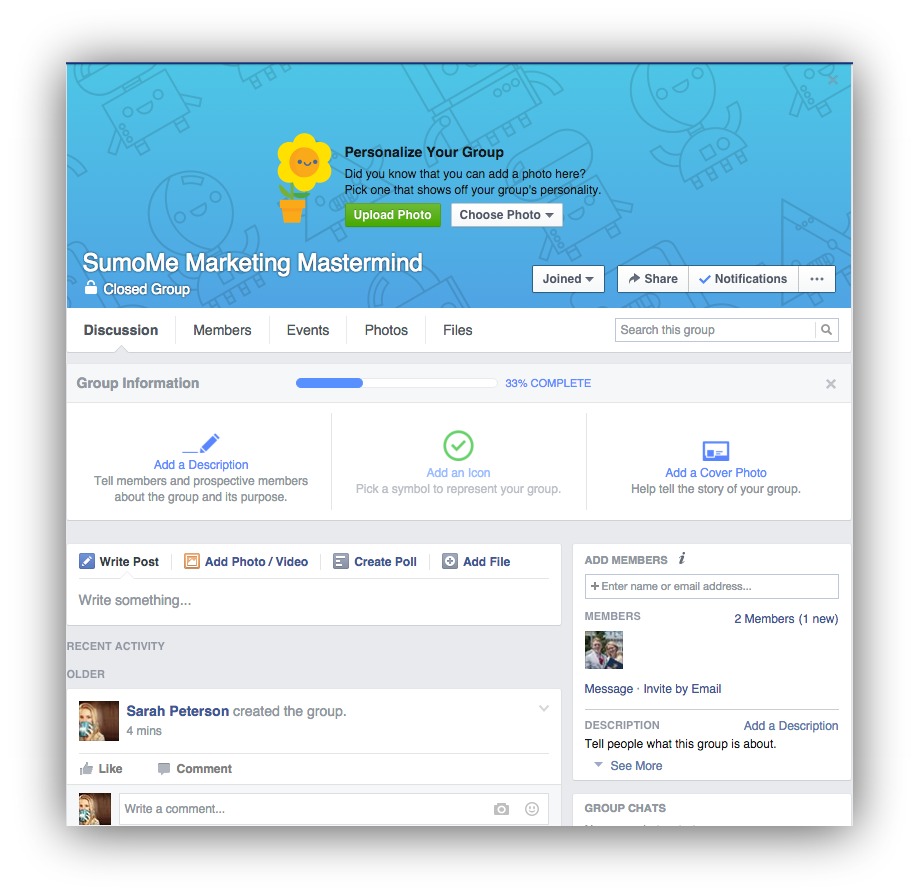
Now...
Set a Photo for Your Group
Your group photo is prime real estate for driving traffic back to your website, so choose it wisely.
Instead of just throwing up a stock photo or your logo, include your URL or a call to action. For example, I am part of a Facebook group for flight deals, and the group admin included and eye-catching group photo with the URL to his website, YVRDeals.com:
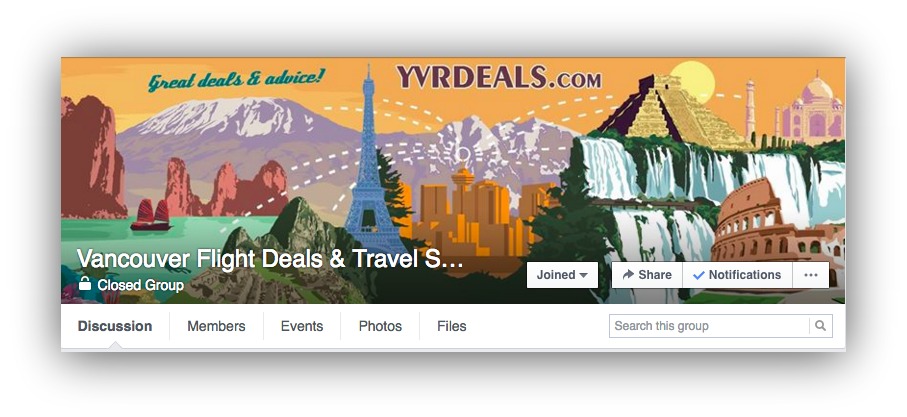
You’re leveraging this prime real estate to become a call to action. We did this with our new group:
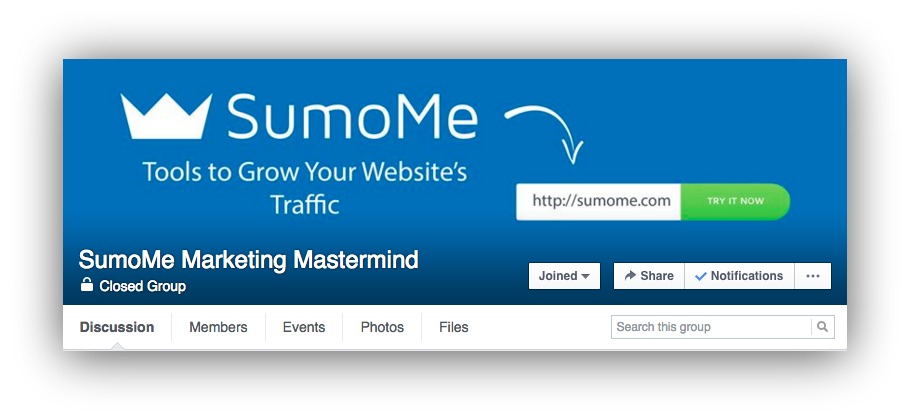
Once you’ve included a compelling image, time to set a group description.
Setting an Interesting Description
In this section, communicate clearly what your Facebook group is about and who it’s for.
You can include your URL in your description as well, which can be a helpful way of driving traffic back to your site. Anybody can see the description of the group if it’s a closed group. They don’t have to be a member.
To take advantage of this prime real estate on your group, write the description like a miniature sales page to get members (or potential members) to click that link or join the group. The Advanced WordPress group does this well:
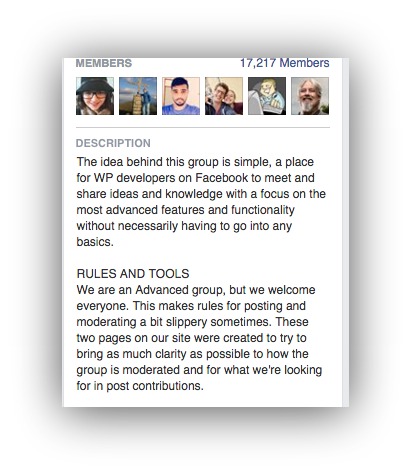
From the description it’s very clear what the group is about, who it’s for, and what goes on inside. Yours should be, too! Here’s what we set as our group description:
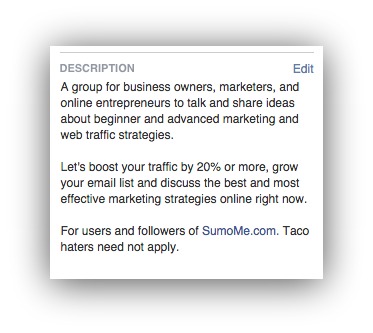
We’ve mentioned who and what the group is for, the benefits of joining and thrown in a bit of the culture at Sumo, too.
Set Your Group Tags
Below your description, you’ll find a place to set your tags.

Tags will help people find your group in search. Use this opportunity to include some keywords or topics people would be searching to find your group. We’ve set our tags as the most likely keywords people will type in when looking for groups on our topics:

This will help potential members find us.
Set a Pinned Post
In Facebook groups, you can “pin” one of your posts to the top of the page so that’s the first thing your members see when they land on your group.
In Kimra Luna’s group, she keeps it short and to the point, including a call to action (“check the ‘events’ tab to the right”), a link back to her website, and a video:
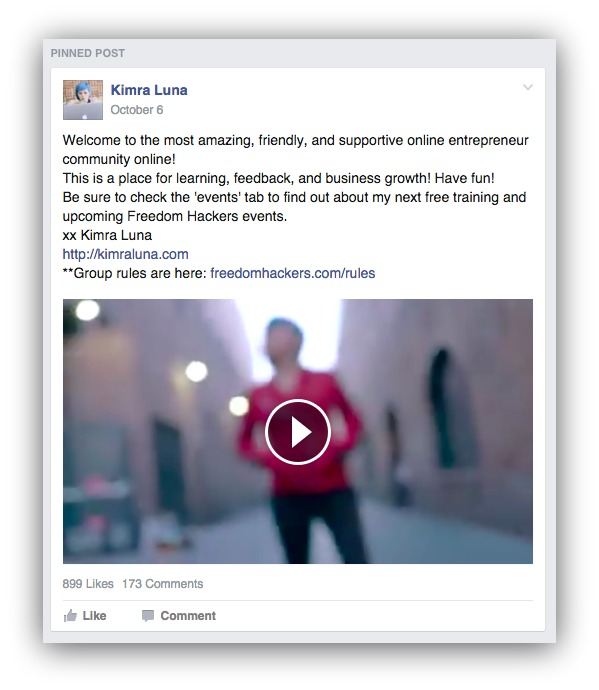
Kimra was smart, because she included the URL and important information before the “read more” cutoff when the post isn’t expanded:
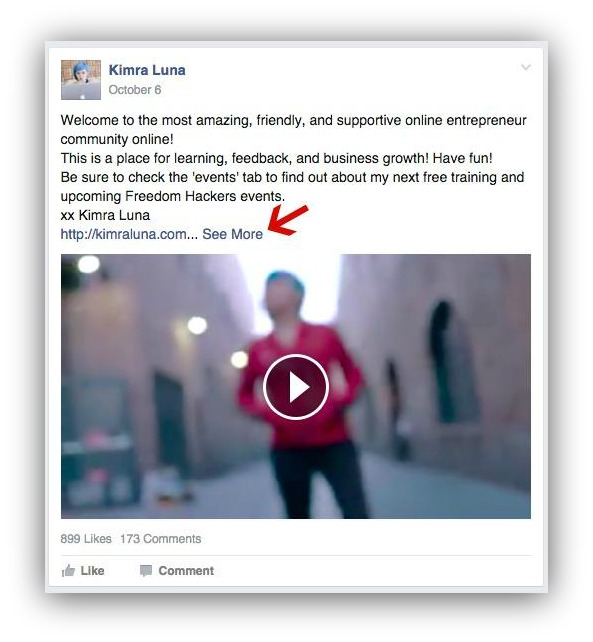
This undoubtedly drives more traffic to Kimra’s website, because the link isn’t hidden.
In your pinned post, set a call to action. Since you’re trying to get more traffic, ask your members to visit your website or a specific piece of content.
As with any call to action, use benefits-driven copy to make following through with that call to action irresistible. We send members to our “Stories” section for marketing resources:
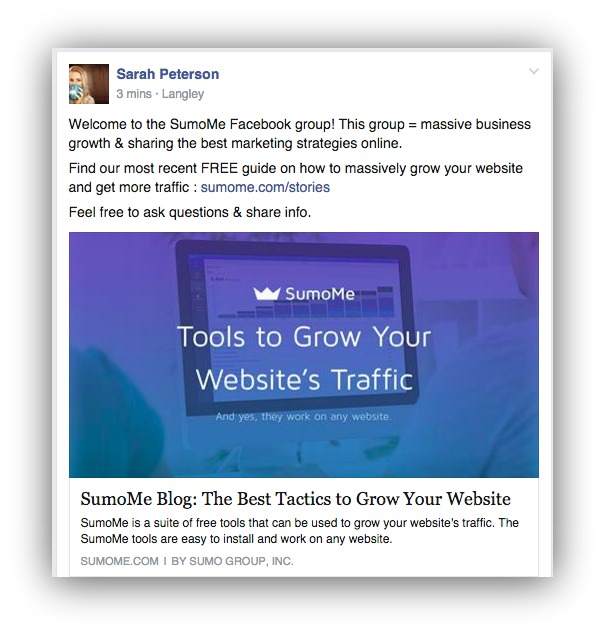
Once you’ve set a compelling pinned post, it’s time to get some members in your group so there’s actually people to click on those links and engage with your content.
How to Get Members for Your Facebook Group
Have you ever considered how easy it is to land more followers on social media compared to how difficult it is to get traffic to your website?
It’s odd, but true.
Luckily, getting members for your Facebook group is easier than driving traffic directly to your website, and (surprise!) more members in your group = more traffic for your content.
Here are a few ways you can land more members:
Link to Your Facebook Group in Your Menu
It’s not uncommon for a visitor to land on your website, consume content, and leave, forgetting about you, your business, and your website forever.
But what if you could drive them to a Facebook group, where your content will show up directly in their news feed?
Do this by posting a link in your menu to your Facebook group to drive members you may have never seen again, like Josh and Jill from Screw the Nine to Five do:

Another, more personal way is to…
Drive Members Through Your Emails
When people send you emails, include your Facebook group in your signature. We often have links to our websites and other social media profiles, but if the person you’re emailing or responding to is invited to join a group, that may be more enticing than clicking on a link. I do this with my Facebook group for my blog Unsettle in a “P.S.”:
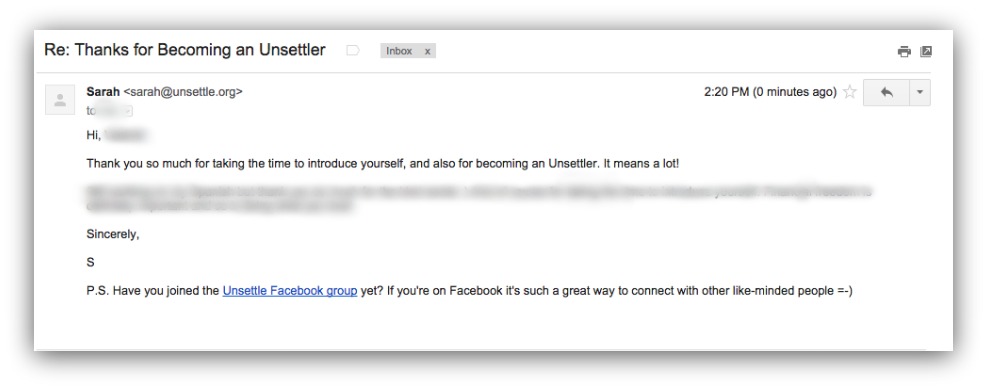
This converts emailers into members like crazy.
Through Other Social Channels
If you’ve built even a small following on social media, tell those followers about your Facebook group.
Twitter, Instagram, and Google+ all have their strengths, but your posts are pushed down into the bottom of the feed so quickly that most of your followers don’t see them.
Getting your followers to join your Facebook group will help you get content in front of them that stays a bit longer.
For my EtsyHowTo Instagram account (tips for Etsy sellers), we link to Etsy sellers Facebook group on Instagram periodically, which always drives 20 or more new members:
On Twitter, periodically send out a call to action to join your group:
Join the Sumo Facebook group (we'll throw down about growth, ? your traffic & best marketing strategy). Cool? https://t.co/4o4KNfkE7n
— Sumo.com (@Sumo) December 22, 2015And you might as well get your Facebook fans into your group. After all, you already know they’re on Facebook:
Pro tip: Spend a couple of dollars to boost the Facebook page post you just made to your existing fans. We spent $100 to boost our post about our new Facebook group:
Which drove the first 100-150 members.
Partner with Other Groups
Unless you’re in a tiny niche, there are other Facebook groups in your industry. Find a few groups that are around the same size as yours and work with the owners.
Will they recommend your group to their members in exchange for you doing the same for theirs? This is similar to the Instagram “share for share” method of gaining followers.
How to Drive Traffic From Your Facebook Group to Your Website
OK, so you’ve done all this hard work to start and grow your group.
Congratulations - you’re done the hard part. Now you just need to leverage your group for traffic. Choose one (or all!) of the methods below and tackle it to get started:
Post Content to Your Group
The lowest hanging fruit for driving traffic from your group is simple:
Post your content to the “Discussion” tab of your group.
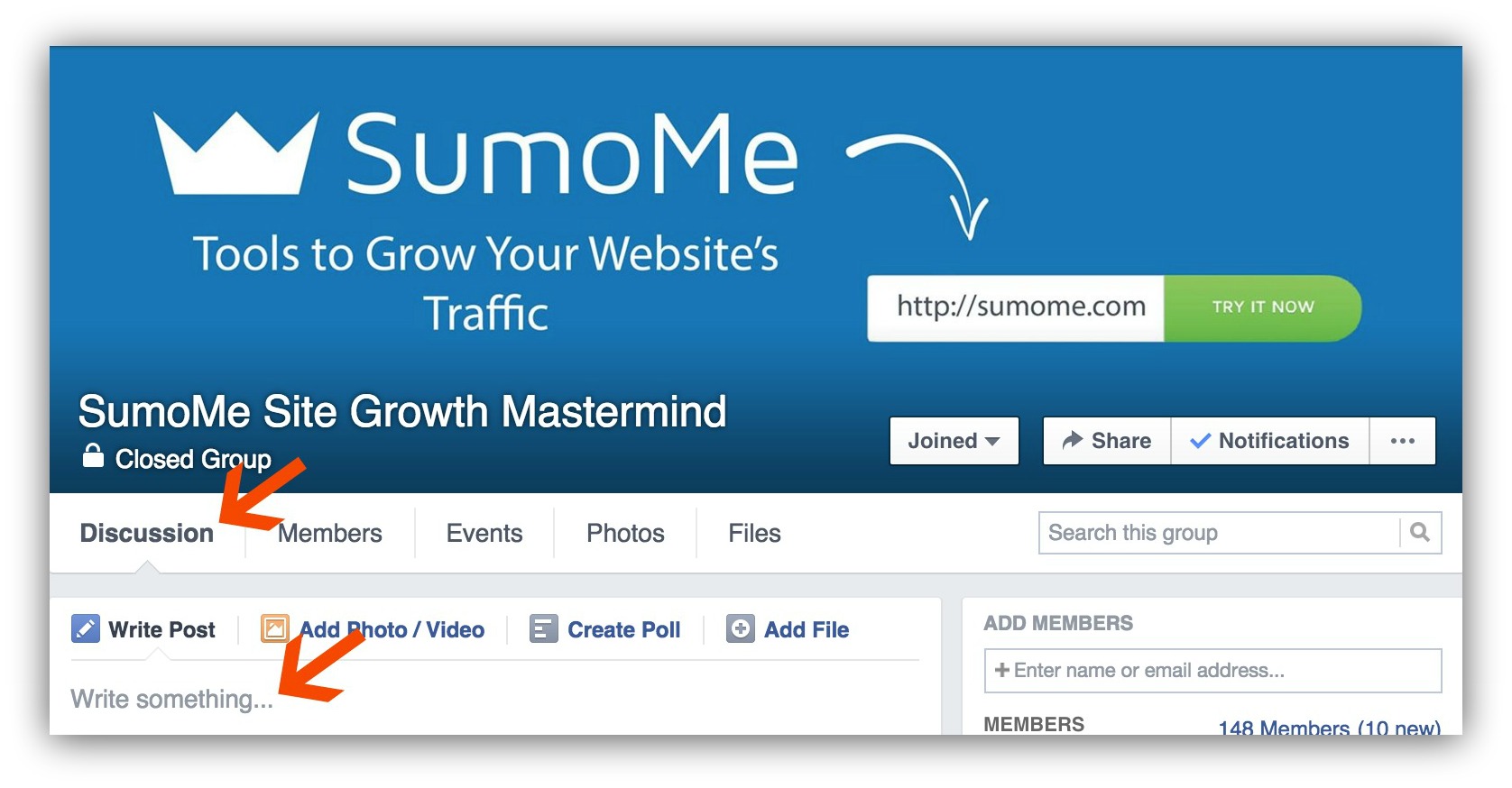
Be careful with this. You don’t want your group discussion to be only your content; this will look too promotional and your members won’t stick around.
How much you can get away with posting depends on how much activity goes on in your group. Aim for your content posts to be 10% or fewer.
When you’re posting in your group, post highly relevant content and don’t just plug the link in and walk away.
Make sure you’re starting a discussion around the content. That’s what a group is for, after all.
Do this by including a personal message in the description. The description you include in a post in your group should be more personal than the one on your Facebook page. Here’s an example of a piece of content I shared with my Facebook group:
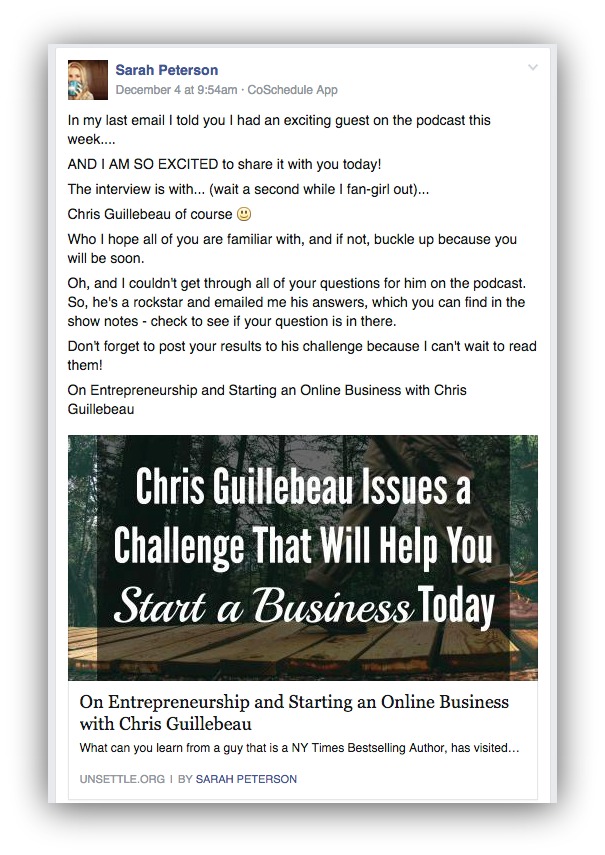
I’m far more personal because I engage with the members a lot more often, and most (if not all) are on my email list.
Compare this with the post for the same piece of content that I shared on my page:
What can you learn from a guy that is a NY Times Bestselling Author, has visited every single country in the world, and...
Posted by Unsettle on Friday, December 4, 2015
When you’re sharing updates to your group, you can use CoSchedule to schedule the posts directly in WordPress to go out when the content is published.
Answer Questions with Your Content
One of the best things about having a Facebook group is that it doesn’t just drive traffic, but it can also be a fountain of market research goodness if you encourage questions and discussion within your group.
This gives you insight into what content to create, as well as gives you the opportunity to provide value through answering those questions with a brief answer and a link to your content that speaks more to the question.
As your group grows and so does your engagement, your members will take care of that for you:
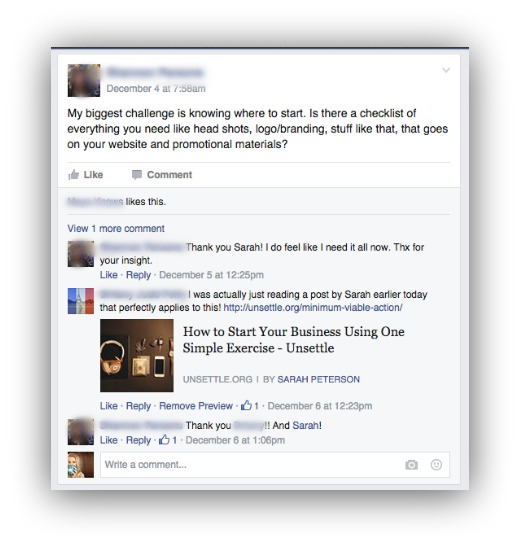
Constant stream of traffic.
How to Reverse Engineer Crazy-Popular Content in Your Facebook Group
Usually content goes something like this:
You create a piece of content based on a hunch or an idea of what you think might be popular. You publish it, share it on social media, and leave the rest up to the content marketing gods. Sometimes, you hit a homerun. Sometimes, the content you worked so hard to create yields unimpressive results.
But what if you could reverse-engineer a piece of content such that it’s almost guaranteed to be popular with your group members?
Luckily, you can - and that’s one of the powers of Facebook groups.
Here’s how:
- Steal content ideas from the minds of your members. You can either do this by paying attention to the questions people are asking in your Facebook group, or just by asking your members what they are struggling with. A simple, one question post to your Facebook group should do the trick. Then, sit back and watch the responses roll in. After you have a few responses...
- Create an amazing piece of content around the trends. In every industry, topic, or niche, there are a few common hurdles. In fitness, it might be fitting in the time to work out. With online marketing, often it’s not enough traffic to your website. When you have not only the hurdles but the language that your members use about them, create mind-blowingly useful piece of content to help them with that struggle. Make it so good members won’t believe it’s free.
- Share it in the Facebook group: Once your epic piece of content is published, share it to the Facebook group, and tag the people who brought up the hurdle you’re addressing.
Let’s say you wanted to learn how to lose 10 pounds, but struggled fitting healthy eating and exercise into your schedule.
If you were reminded of this painpoint by describing it in a Facebook group, and then were presented with an entirely free solution to the pain point in the form of a crazy-useful piece of content, would you not be practically begging to read, share, and engage with it?
Sound like too much work to start your own group? You could always…
Strategy #3: Boost Your Visitors by Participating in Established Facebook Groups
If you don’t want to start your own Facebook group, but you still want to reap some of the benefits you can always participate in established Facebook groups.
Notice how I said participate. Nobody likes a spammer, and that’s true across all group mediums.
If you’re taking this route, remember to always give more than you take. Make sure your posts are value-added rather than promotional in nature. And make sure the group guidelines are okay with posting your content or work.
If you add so much value to the group without linking to your content, members will welcome the information you link to as well. To drive traffic from established groups, you have to post content (or links) back to your website or group. Here’s how to do so without pissing anyone off.
Include Your Links in Your Intro Post
When you first join any type of group, you probably should introduce yourself. Otherwise you might come off as a weird lurker ;)
In your intro post, it’s almost always okay to mention your website and add a link. For example, if I were to join a group about marketing, I might say…
“Hi Everyone!
Just wanted to quickly introduce myself as I’m new to the group. My name is Sarah Peterson, and I am a Content Sumo for Sumo.com (tools to grow your website’s traffic). I specialize in content marketing, specifically written content, and have grown several profitable businesses in the past, so I hope I can provide value as well as learn more about marketing. Thanks for letting me join!”
This is a one-time opportunity for each group you join, but it’s worthwhile because intro posts can help you build relationships within the group as well.
Answer Questions with Links to Relevant Content
Facebook groups are a great place for members to post their questions.
For you, this is an opportunity to establish yourself as an expert, build relationships, and provide value to the members. Engage in the group, and provide thoughtful, detailed answers a few times per day to the members.
Sometimes, you will have content that addresses the person’s question. Still type out your answer, but include a link at the end if they want more information.
Do Something Interesting (and Link to a Tutorial)
If you do something that the other group members would love to learn, linking to a tutorial on your website is usually welcome.
Check out how one blogger did this in a beginner photography Facebook group:
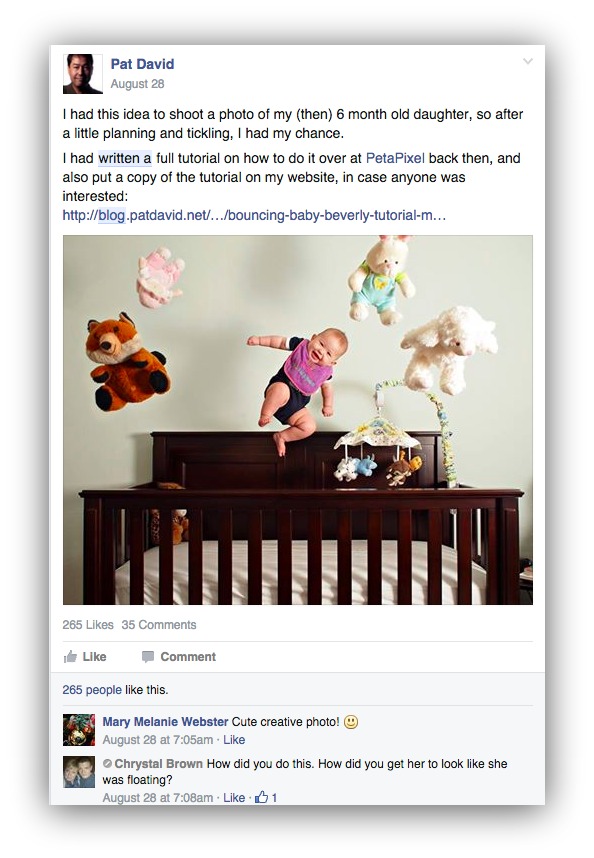
Not one comment in the thread complaining about linking to the content, and 265 likes. This post definitely drove a ton of traffic, too.
Offer to Moderate the Group
Group owners have a lot on their plate. Many of them are juggling businesses of their own, websites, jobs, and personal commitments.
After participating for a few weeks, send the group owner a direct message to offer to help moderate the group by answering posts and keeping the conversation going.
Often moderators get a lot more leeway in what they can and can’t post, and becoming a moderator for a popular group gives you access to hundreds or thousands of members of your target audience.
Post Your Content Directly (but Only after Adding Tons of Value)
You can promote your own content in an established Facebook group without being spammy, but it takes a lot more than just copying and pasting your link. Here’s how not to post your content directly to a group:
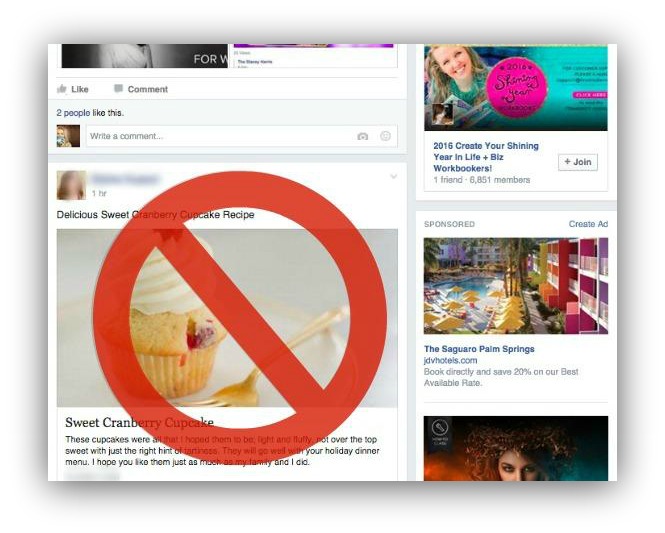
This is not the owner of the group and it adds little to no value to this group (it’s an entrepreneurship group, after all).
Instead of just posting random articles you’ve written, provide actionable, unique, tips and tricks like Assya did below in the Being Boss Facebook group:
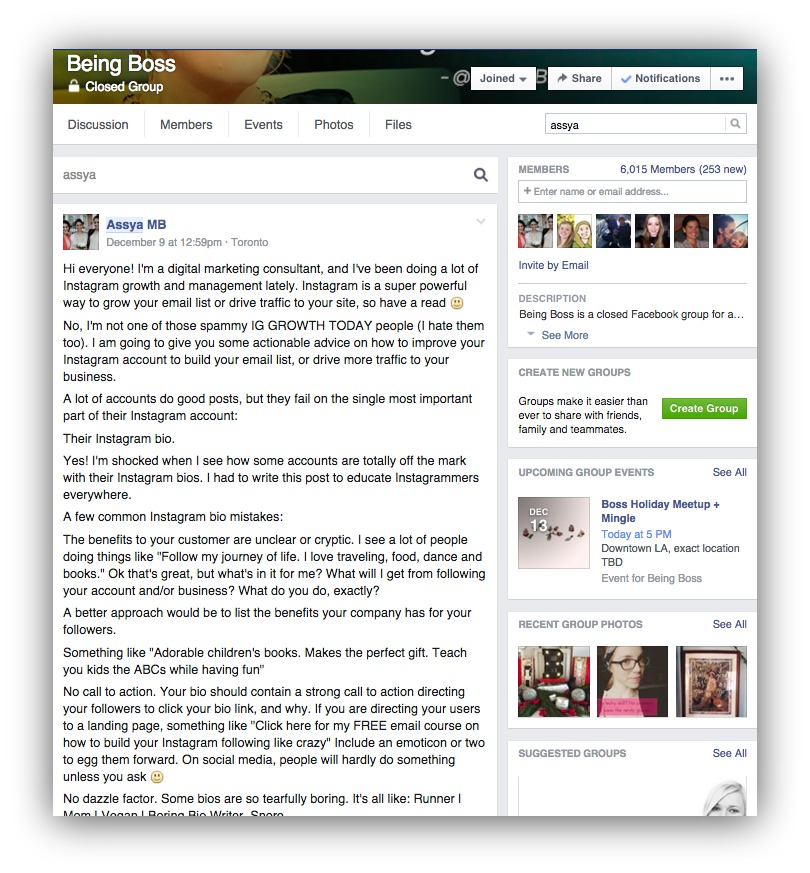
After a longer, detailed, value-packed post, add a link to the end for those who want more information.
If you don’t feel comfortable adding the link, often somebody will ask you for it in the comments.
“Cross Post” to Drive Their Members to Your Group
If you post a detailed, value-packed post to your own group (or, on your own Facebook page), try “cross posting” the post into another Facebook group.
Mention that you are cross posting it, and where from. Members may become curious about your group or page and click onto it, where you can share more of your content with them and build a relationship with them.
Share When You’re Invited
Sometimes Facebook group admins make sharing easy by inviting members to promote their work. Usually they do this in a post they write specifically to keep promotion contained or a themed day. You can...
Respond to Admin Posts
If you’re invited to share, by all means, do! Nathalie Lussier invites her members to share their opt-in offers in her 30 Day List Building Challenge Facebook group:
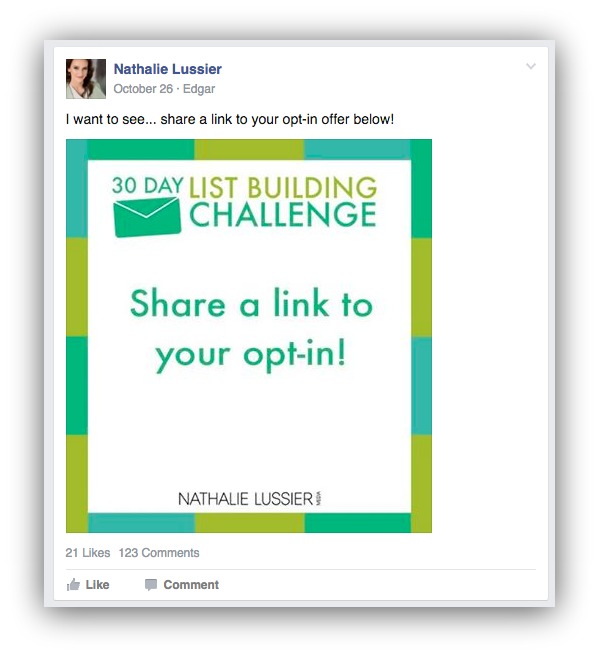
If you are a health coach or a food blogger and the group administrator invites members to share their favorite recipe or food tip, use that opportunity.
Participate in Theme Days
Who doesn’t love a good #ThrowbackThursday?
Okay so you probably won’t drive traffic by posting photos of your 80s hair, but “theme” days in an established group can be opportunities for driving traffic.
An example of a theme day might be if a group did a “Share Wednesday” or a “Tips Tuesday”. The Screw the Nine to Five Facebook group for example does a Follow Friday:
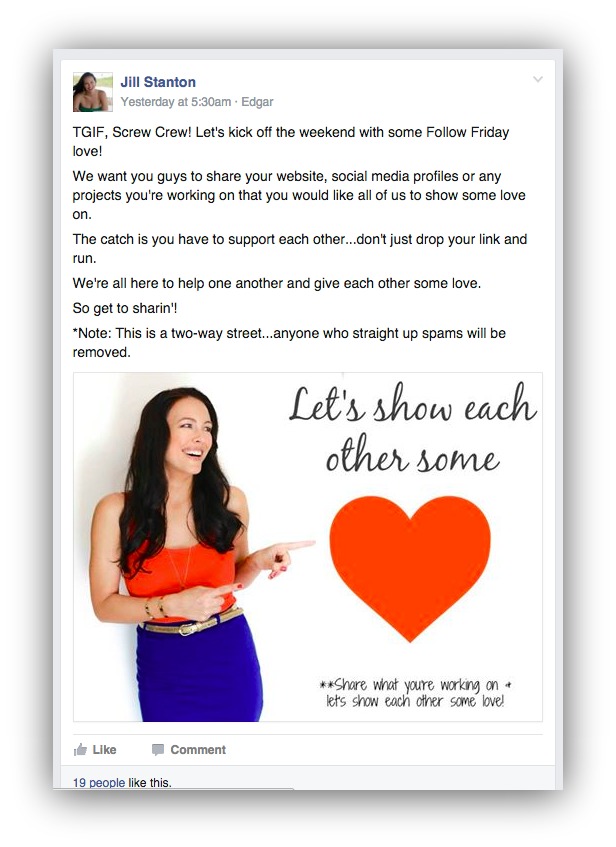
The group owner, Jill, invites members to share and promote what they’re working on.
Maximize these opportunities by - you guessed it! - providing massive value before you share your content.
Established Facebook groups can be a great place to engage with your target audience and drive them to your website, as long as you do them right.
Strategy #4: Get More Facebook Fans for Wider Reach
Let’s be real:
Without Facebook fans, your Facebook page won’t drive traffic. And it doesn’t matter if you have the best organic reach on the social network if you have no fans news feeds to reach.
Your Facebook fans will be the people who engage with your Facebook posts, click on the links, and return to your website. So try out these strategies for getting more Facebook fans (and more traffic by extension).
Make it Easy For People to “Like” Your Page
Remember what I said up there about the 8-second attention span?
That means that, just like your existing traffic sharing your posts, nobody is going to hunt for that “like” button on Facebook. You need to make it easy.
Copy the Facebook pros, like Amy Porterfield, and include a Facebook “like” box on your website:
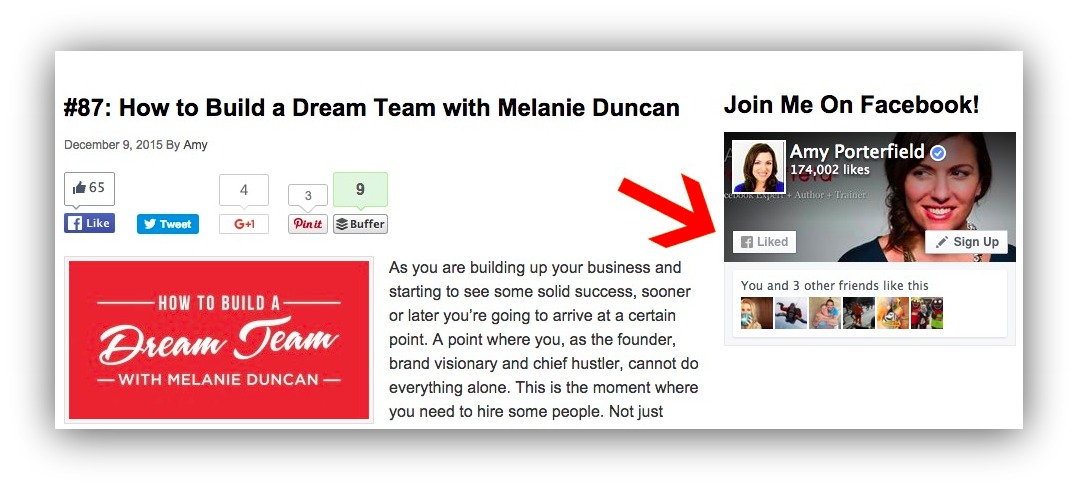
You can either install a plugin on your WordPress website, or grab the code Facebook provides by clicking here.
Or, to make things super easy, you can have a Scroll Box or Smart Bar push people to like your Facebook page.
If the problem is that you have virtually no traffic (yet), that’s ok. You can get more fans on Facebook itself.
Get Your Facebook Friends to Like Your Page
Are you more willing and interested to like a page that has zero likes? Or one that already has thousands?
Definitely the latter. That’s because the other few thousand people who liked the page provide social proof that it's a worthwhile page.
Social proof is powerful, and you need it on your side to get more Facebook fans. Your existing network can kickstart that social proof; you just have to get your Facebook friends to like your page.
There are few ways to go about this. Two are more passive, and two will take more legwork but yield better results.
Add a Link to Your Page in Your Personal Profile
When people visit your personal profile, you can give them the chance to like your Facebook page in your personal information.
Go to your personal profile and press the “Update Info” button on your cover image.
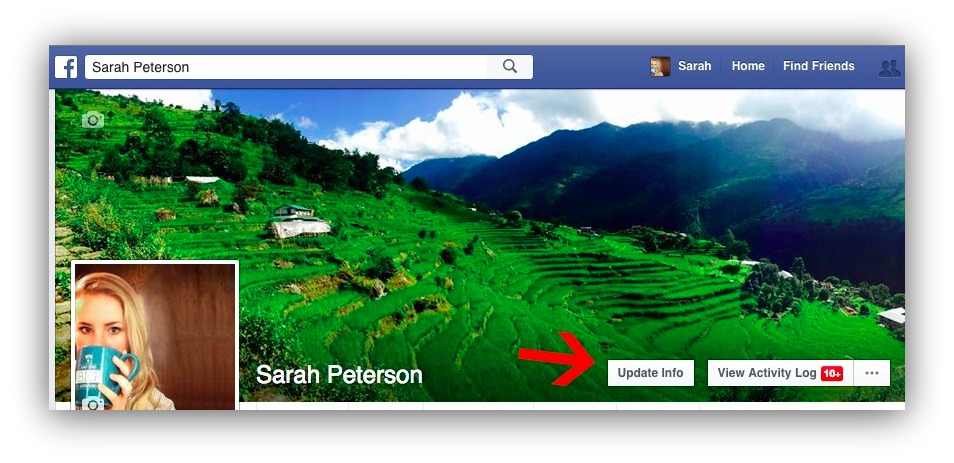
Then, type your Facebook page’s name into the “Work and Education” under “Company”. Select your page:
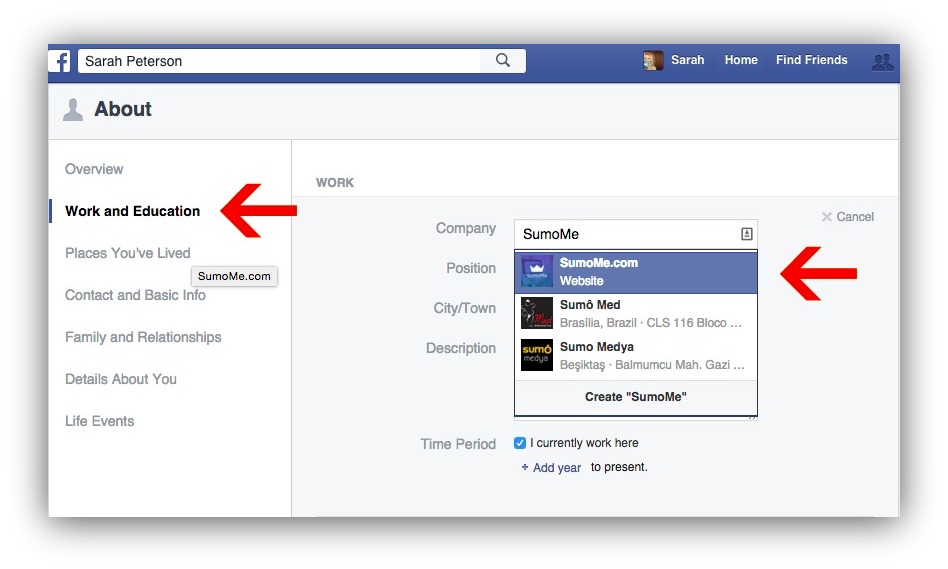
Type in your “title” and press “save changes”:
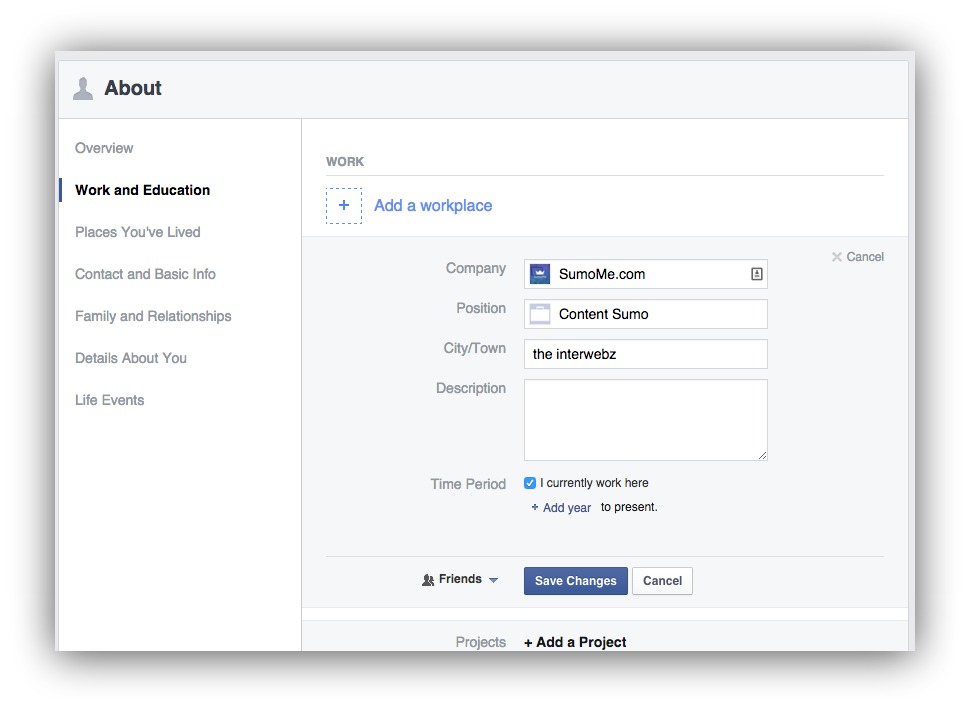
This places a link to your Facebook page in your personal profile for your existing network to like, kickstarting that social proof:
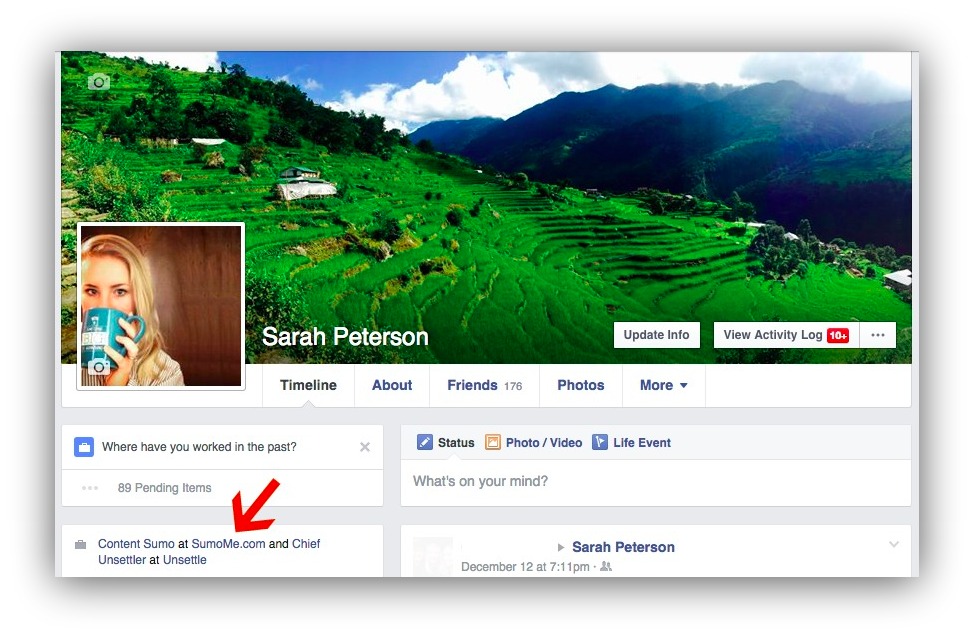
Bonus: set this portion of your personal profile as public so everyone can see and like your page, not limiting it to just your friends.
Share Your Facebook Page to Your Timeline
Did you know you can actually share your Facebook page to your timeline?
When you share something on your timeline, it shows up in many of your friend’s news feeds. Plus, once it’s on your timeline, you can tag your friends in it for a little public accountability.
To do this, visit your Facebook page, and press the “Share” button on top of your cover photo:
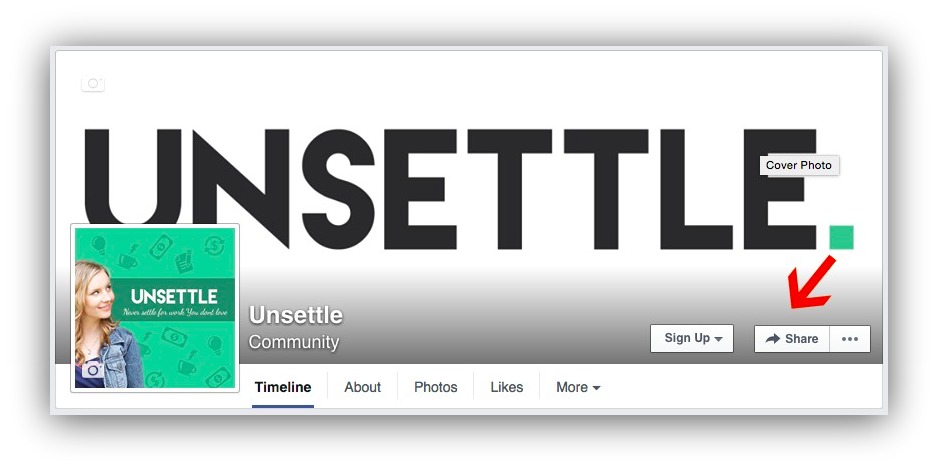
Then, set it to “Share on your own Timeline” (you can also share it in a group, or on a friend’s timeline, which we will get to later):
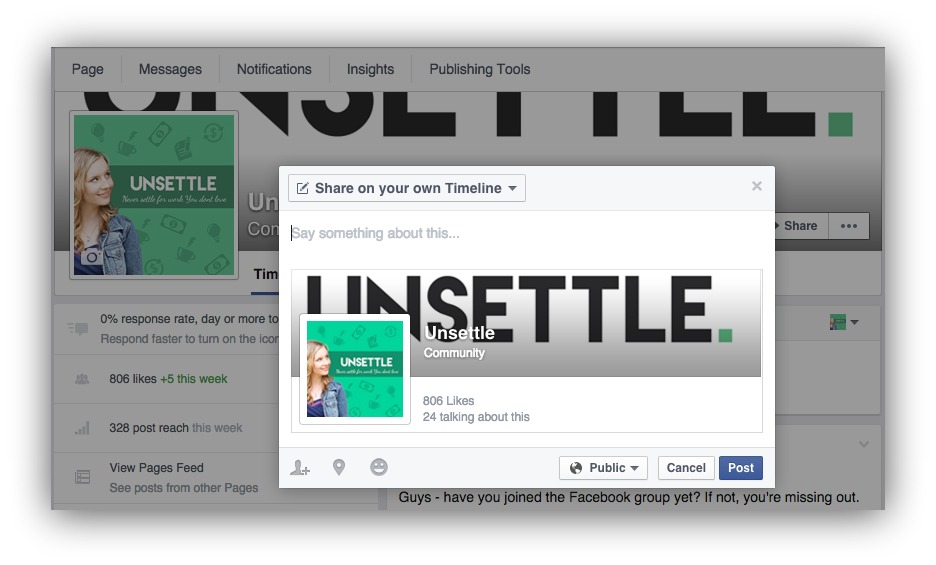
Write a nice, personal description asking your friends to like your page. Something like:
“Hey guys! I’m trying to build up my business’s Facebook page and would appreciate your support. Can you please like my page?”
Then, add a location to your post if your business is local (or even if you just want more fans from a specific city). This will help people find it who are looking for posts in that location.
After you share your page to your timeline, you can comment on the post and tag your friends who may be interested. If those friends don’t like your page after you tag them, you can ping them again with the strategy below.
Suggest Your Page to Your Friends
In this active method of getting your friends to like your page, you’re actually suggesting they like your page.
On your Facebook page, press the “share” button at the bottom of your cover image. Select “Invite Friends” in the drop down menu:
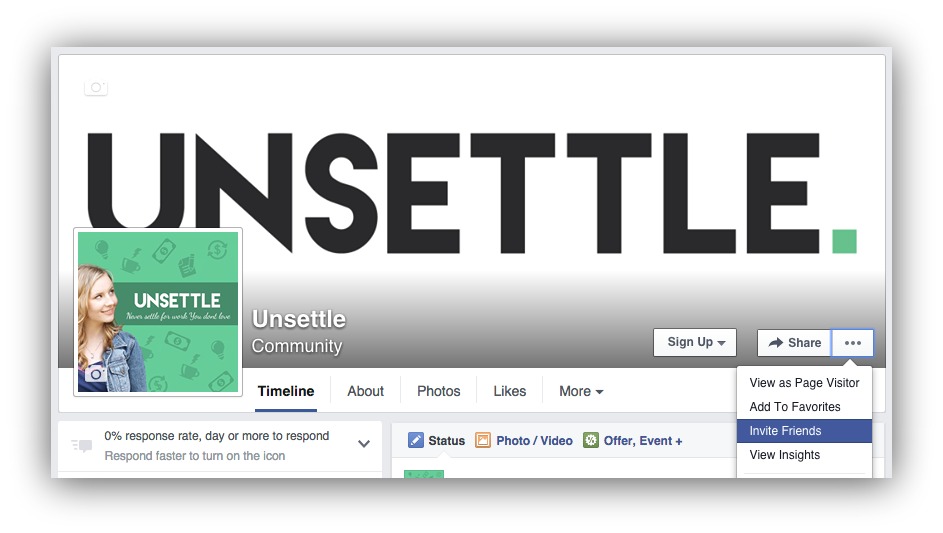
Then individually invite your friends to like your page.
This method requires more legwork but is more likely to convert your Facebook friends into Facebook fans, because you’re actually asking them.
When a friend asks you for a favor - especially when it helps them grow their business - you’re probably happy to oblige, right? Hopefully your friends feel the same way about you!
Find out by asking them to like your page.
Ask Your Friends to Suggest Your Page to Their Friends
This next method of getting Facebook fans might be a little less comfortable, because it requires you to actively ask favors of your friends. But what are friends for, right?
Here, go over to your page and share it just like you did to your timeline above.
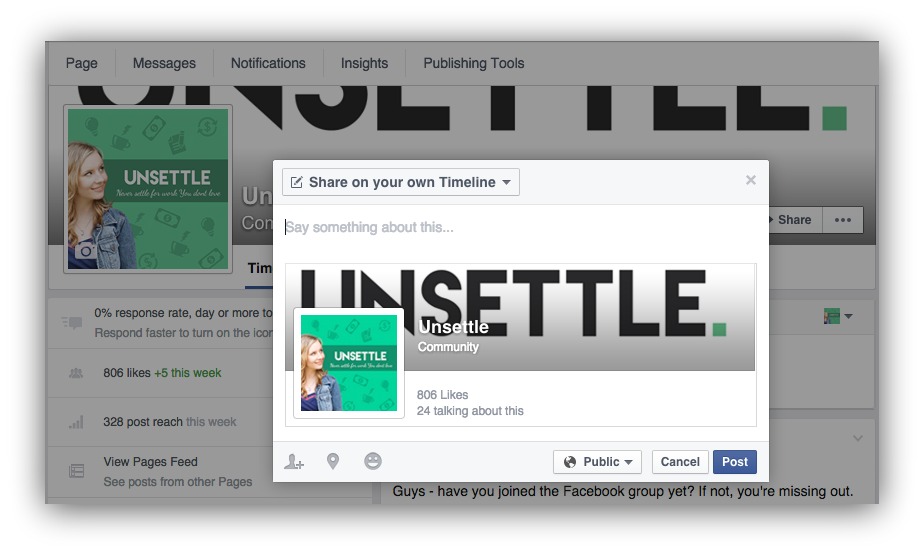
Send private messages and ask them to send your page to one or two friends they think would enjoy it:
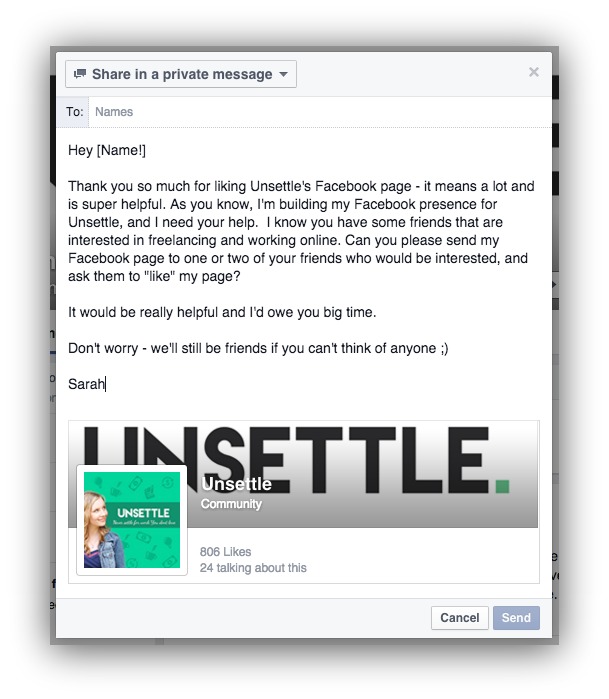
Personalize your message so you don’t sound like a robot, and send this request to as many friends as you possibly can who you know are connected with people who may be interested in your topic.
Share with Members of Established Facebook Groups
We just talked about getting involved in established Facebook groups to drive traffic. As you’re participating in the Facebook groups, sometimes you can ask the members to like your page.
Make sure this isn’t against group guidelines, but having people like your page is usually more acceptable than blatant self promotion with your articles.
Members have done this for within some of my groups, like this post on my Etsy Seller’s group:
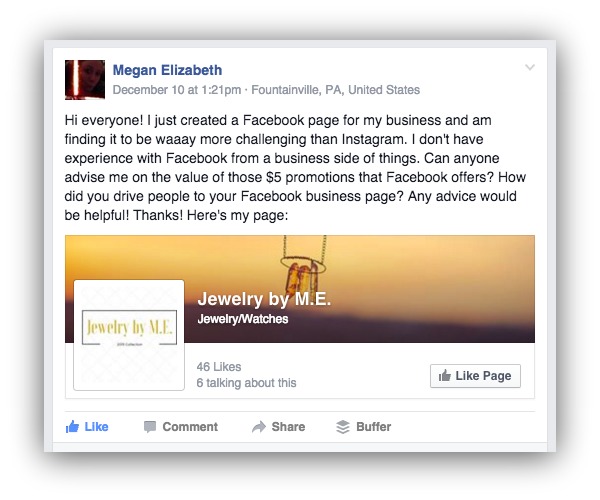
Since the members of that group are supporting each other through working toward a similar goal - building and running successful, profitable Etsy shops - I love that they support each other in this way.
Run a Giveaway for Likes
Giveaways can drive a ton of likes in a short period of time.
Choose a giveaway that will attract your target audience. You’ll get a lot of likes if you choose a more general item to give away, like an iPad or an Amazon gift card, but they’ll “unlike” en masse after they’ve found out they haven’t won.
When you’ve chosen what you want to give away, set it up in KingSumo Giveaways or Rafflecopter for one of the giveaway entry options to be Facebook “like”.
Then, submit the giveaway to popular giveaway directories, including:
Promote the giveaway online in other channels, too:
- StumbleUpon
- Reddit (careful with this one)
- Google+ Communities
- Facebook groups
- On your Facebook page
- Ask influencers and bloggers to share it
- Write a blog post promoting the giveaway.
We created a giveaway of the Sumo team’s favorite books for the holidays. This is highly targeted to our fans, because our target audience loves our brand.
To promote the giveaway, we wrote a blog post about it:

Included the call to action at the end of the post for people to enter the giveaway:
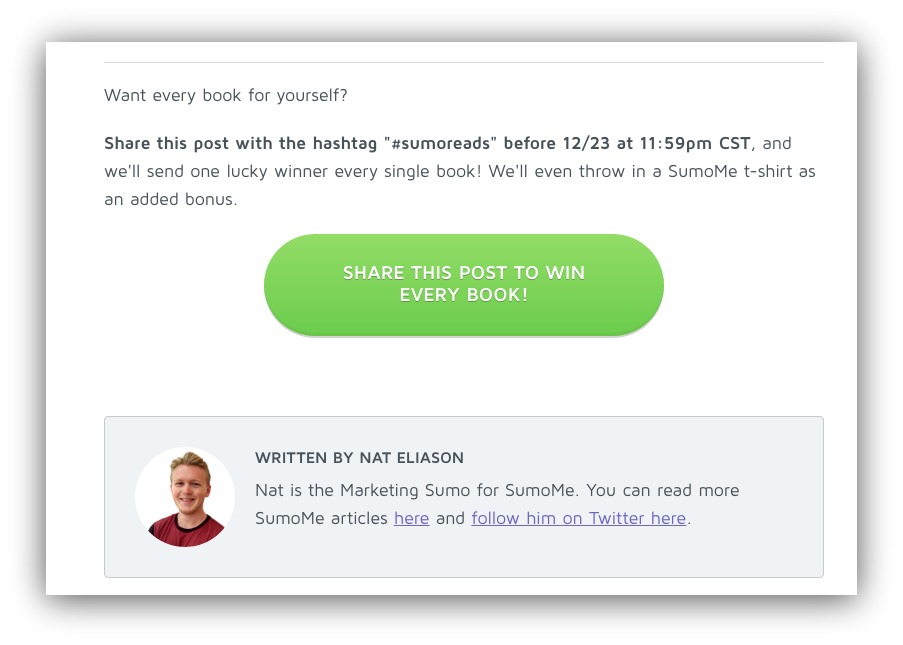
We did this with our most recent giveaway for Twitter shares, but this can just as easily be done for Facebook likes.

Because a Facebook like is a easy and low-commitment action, this will explode your Facebook likes, and therefore the amount of people you can drive back to your website from your page.
Mention Influential Brands/Influencers in Your Content
Wouldn’t it be nice if people who ran pages with established followings would just share your content?
One way to get noticed by owners of Facebook pages that are established is by championing them on your Facebook page and tagging them in it, like this blogger did with TOMS:
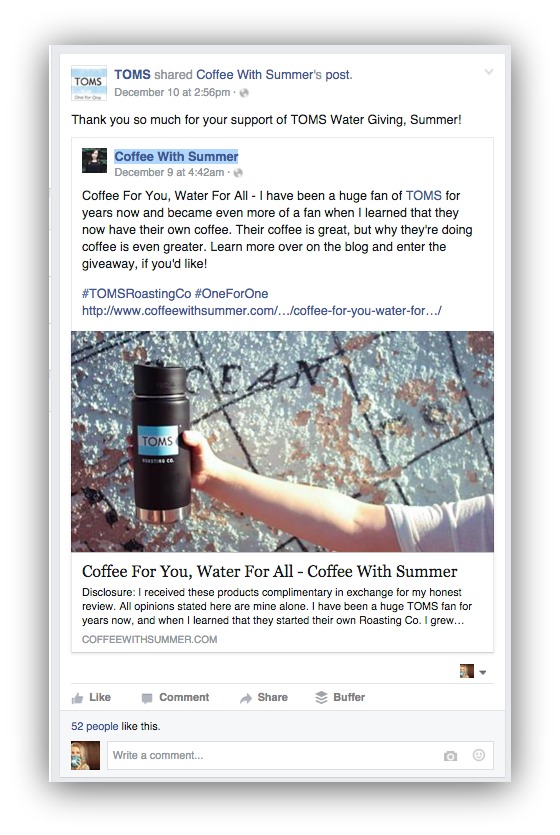
TOMS then shared the post to their 3.4 million+ fans. You can either create content about the influencer or just write a Facebook post and tag them in it.
You can take this one step further by sending them a friendly email, making it easy for them to share it by writing a description for the share that they can just copy and paste.
Tag Influencers’ Personal Profiles in your Facebook Posts
Want to get your page in front of thousands of members of your target audience?
Mention influencers who have public profiles on your page. Tag them in the posts, so it shows up on their timelines. Tropical Entrepreneur did this with a “happy birthday” message to John Lee Dumas from Entrepreneur on Fire:
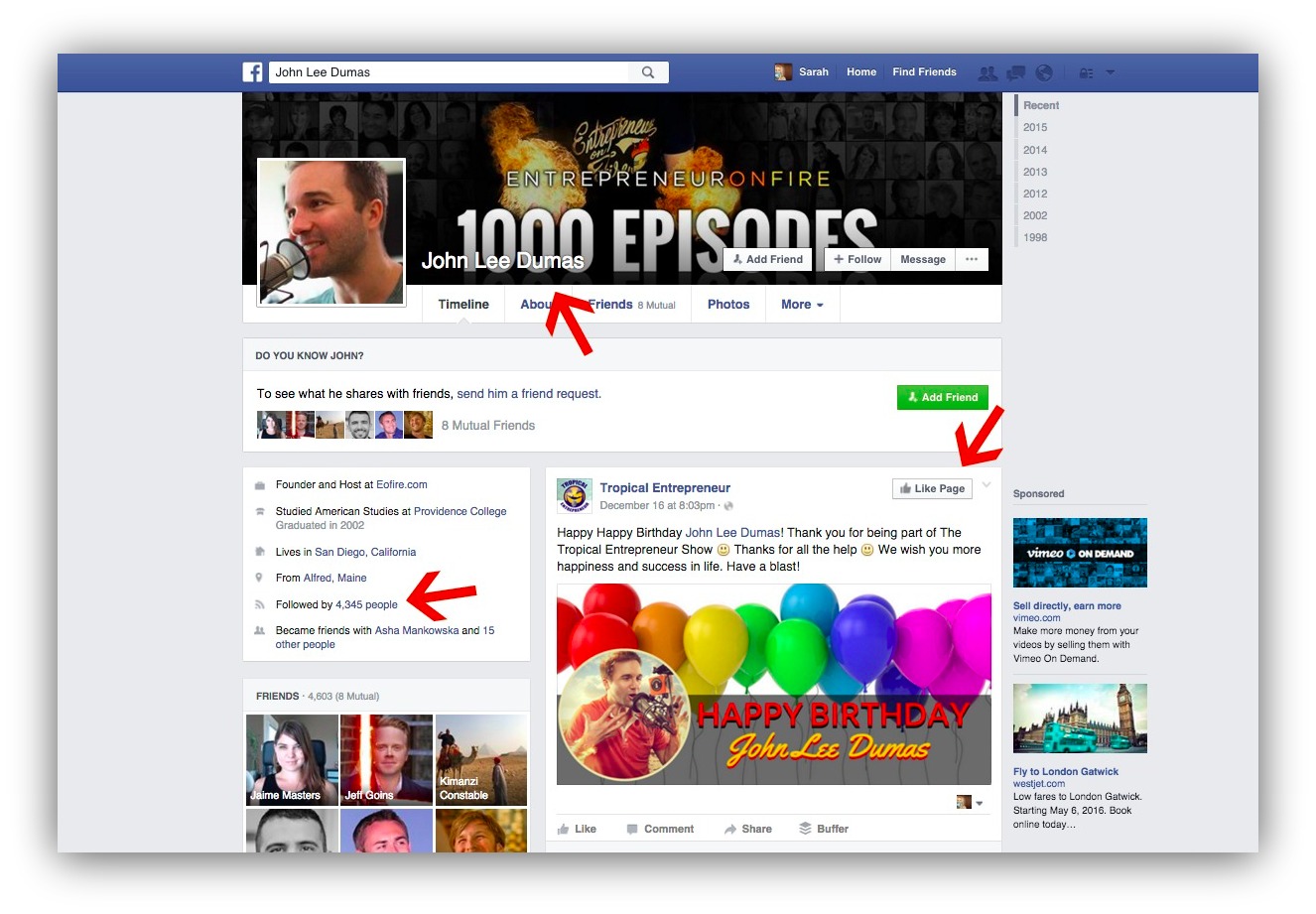
John has 4,345 people following his profile, and Tropical Entrepreneur is now in front of some of those people.
Pick a couple of influencers in your space you’re familiar with who have public profiles and large followings and shout them out from your page. Be genuine - nobody likes a fake.
When you increase your likes, you are increasing the audience your page posts have, and therefore the traffic those posts snag.
Strategy #5: Maximize the Reach (and Traffic) from Your Facebook Page
Facebook is the new Google when it comes to pissing off marketers.
It once was a great free marketing platform, but with constant changes to the news feed algorithm, chances are your posts to your Facebook page don’t get a quarter of the amount of interest as they did before…
And that’s because hardly any of your Facebook fans even see your post.
So how do you maximize the reach of your Facebook page if those fans you just worked so hard to get aren’t even seeing your posts?
Instead of throwing in the towel on Facebook pages entirely, try to increase engagement on your posts. Having a Facebook page can help you increase your search engine rankings - and therefore search engine traffic - so don’t overlook your page’s importance.
Engagement works because when your fans engage with the content you’re posting, it sends a message to Facebook that they like what you’re sharing. Facebook wants to put things that your audience actually likes into their news feeds. So when people are engaging in your posts, more of them will show up in their news feed, increasing your organic reach.
How do you drive engagement? Let’s first talk about what type of content to post. Then we’ll get to when to post it to drive the most engagement.
Types of Content to Post
On every social platform, there are certain types of content that do better than others. Here’s what has been working on Facebook.
Start with Posting Topics Your Audience Desperately Wants
All good Facebook posts that drive engagement start with posting about things your audience is actually interested in.
Don’t worry though. You don’t need to guess. There’s a tool for that!
In this excellent Moz video about Facebook, Rand Fishkin provides a protip to use BuzzSumo to research what topics are doing well in your niche:
You can plug in keywords and see the pieces of content that over the past six months or a year have performed the best across social networks, and you can actually filter directly by Facebook to see what’s done best on Facebook in my niche, with my topics, around my subjects.
For example, if you were in the bodybuilding industry, you might type in the keyword “build muscle,” then sort by shares on Facebook:
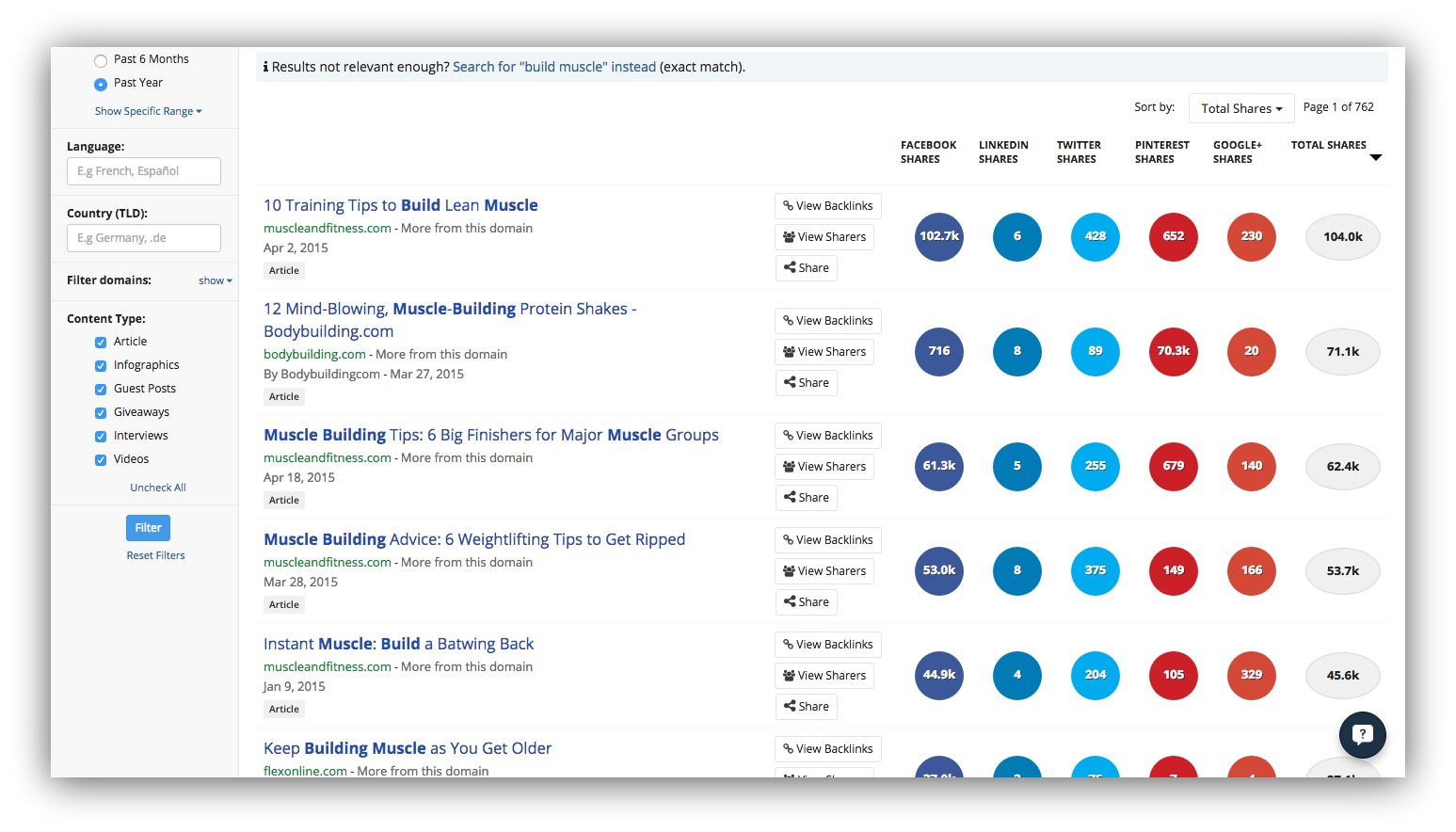
Then, share content on Facebook that you know will be what your followers want to hear more about. In this case, they might want tips to build muscle, information about protein for muscle building, or information about targeting certain muscle groups.
Once you find out the exact topics to post on Facebook on BuzzSumo, you can figure out what type of content to post, and when.
Video Content
Socialbakers has demonstrated that videos outperform all other types of posts in organic reach.
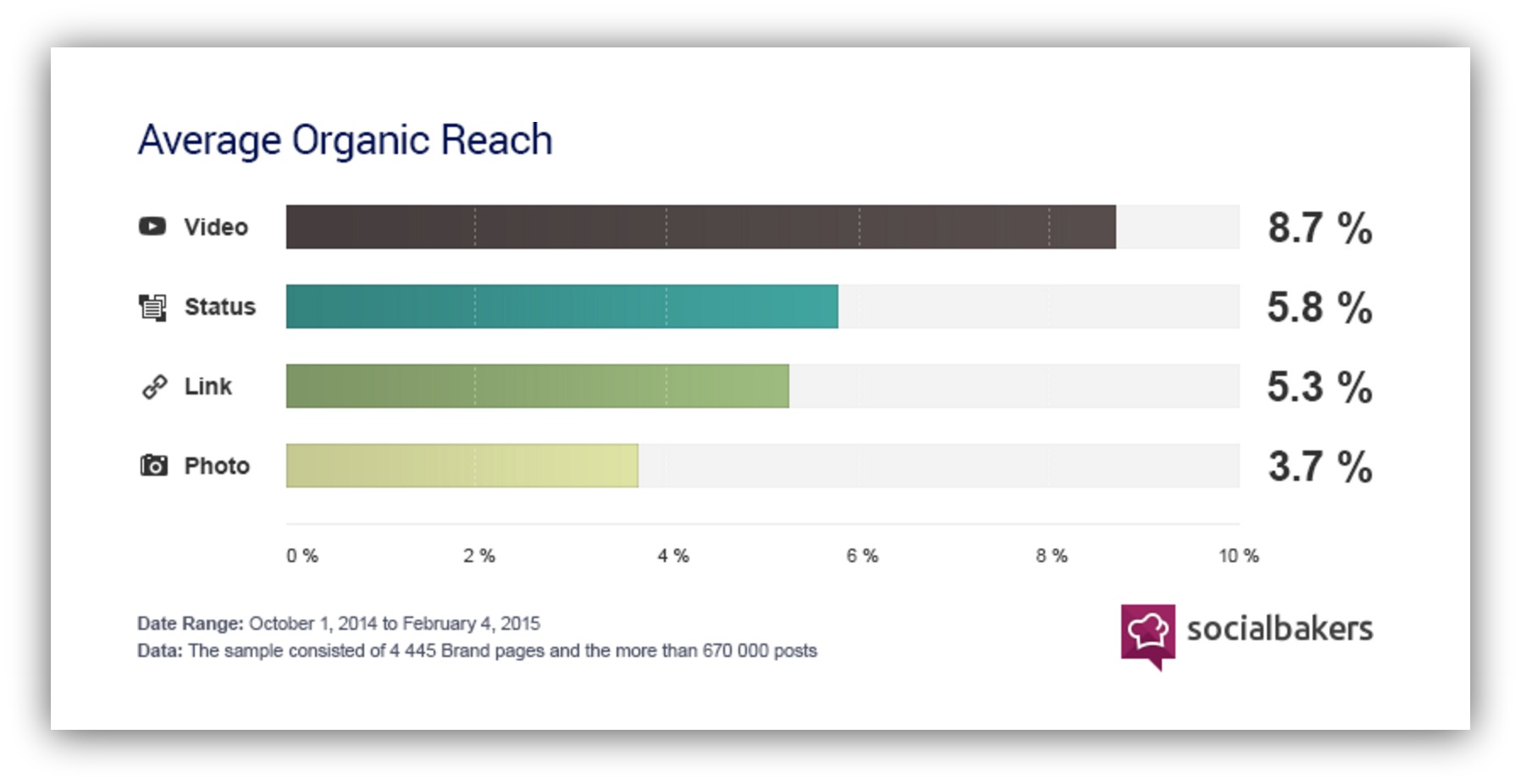
You can see proof on almost any Facebook page you look at. Take these two posts from Mashable, for example. The video is on the left, and the photo post is on the right:
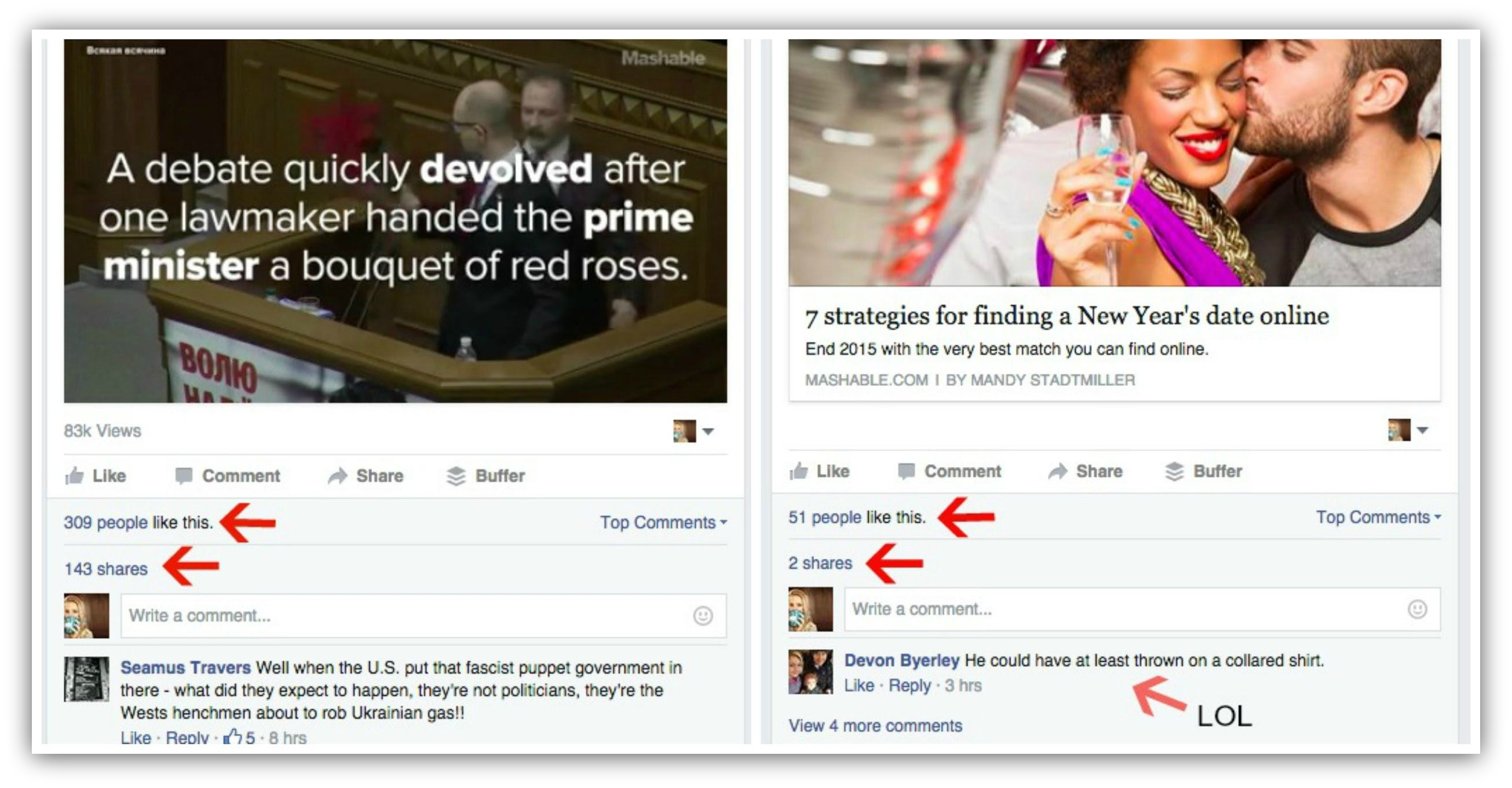
It’s hard to deny that video content works like magic on Facebook. So try video to see if it drives engagement with your posts.
Longform Content
A few weeks ago we mentioned in our guide to the different types of testimonials that longform content works.
Facebook is no exception.
If you assumed that because we have the attention span of a goldfish you should only post quick snippets of content, you assumed wrong. And you know what they say about assuming things…
An analysis of 100 million articles shows that longer content is far more likely to be shared than short content on Facebook:
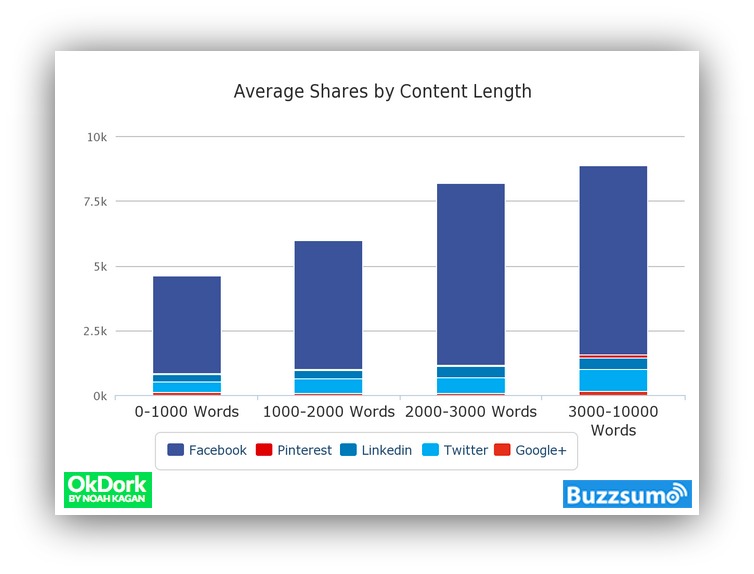
Posting longform content gives you a sense of credibility and shows your Facebook fans that you provide massive value.
You want to post such long and valuable content that they are practically begging for more and hunting for the link to your website.
With long content, you can also tell a story to connect with the the readers, and create a compelling call to action. Derek Halpern did this well with a recent post:
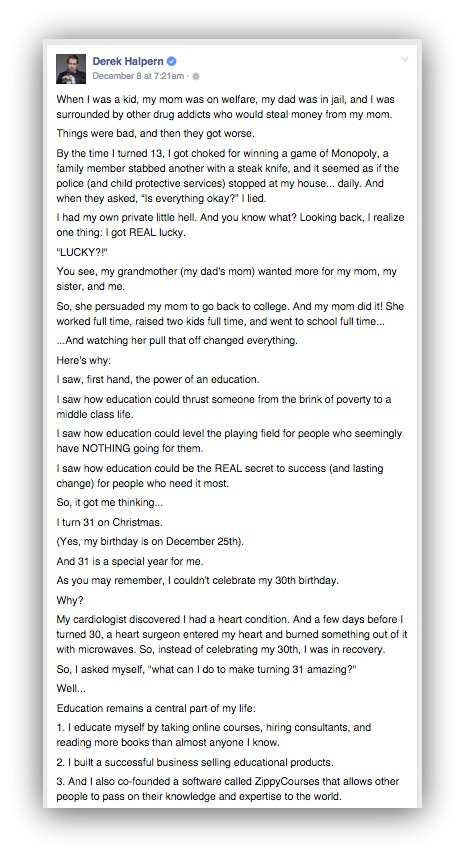
It also turns out that posting longer content works double duty. Facebook’s news feed algorithm takes into account time spent on posts. The longer the post, the more time your fans will spend to read it, boosting news feed visibility. Boom!
Quick, Digestible Text Posts
To increase engagement with your page and show Facebook that your posts are worth the almighty news feed, you don’t always have to post links, images, and videos.
A lot of people have found success with just posting snackable text posts. Gabby Bernstein took this route with one of her recent posts:

And it drove almost 2x more likes and 2.5x more shares than the image post she posted just two hours before:

You can also play some trivia with your followers by asking...
Simple Questions
People love to answer quick, simple to answer trivia-type questions. Pat Flynn did a quick experiment in asking his audience a question from his Facebook page which drove a ton of engagement:
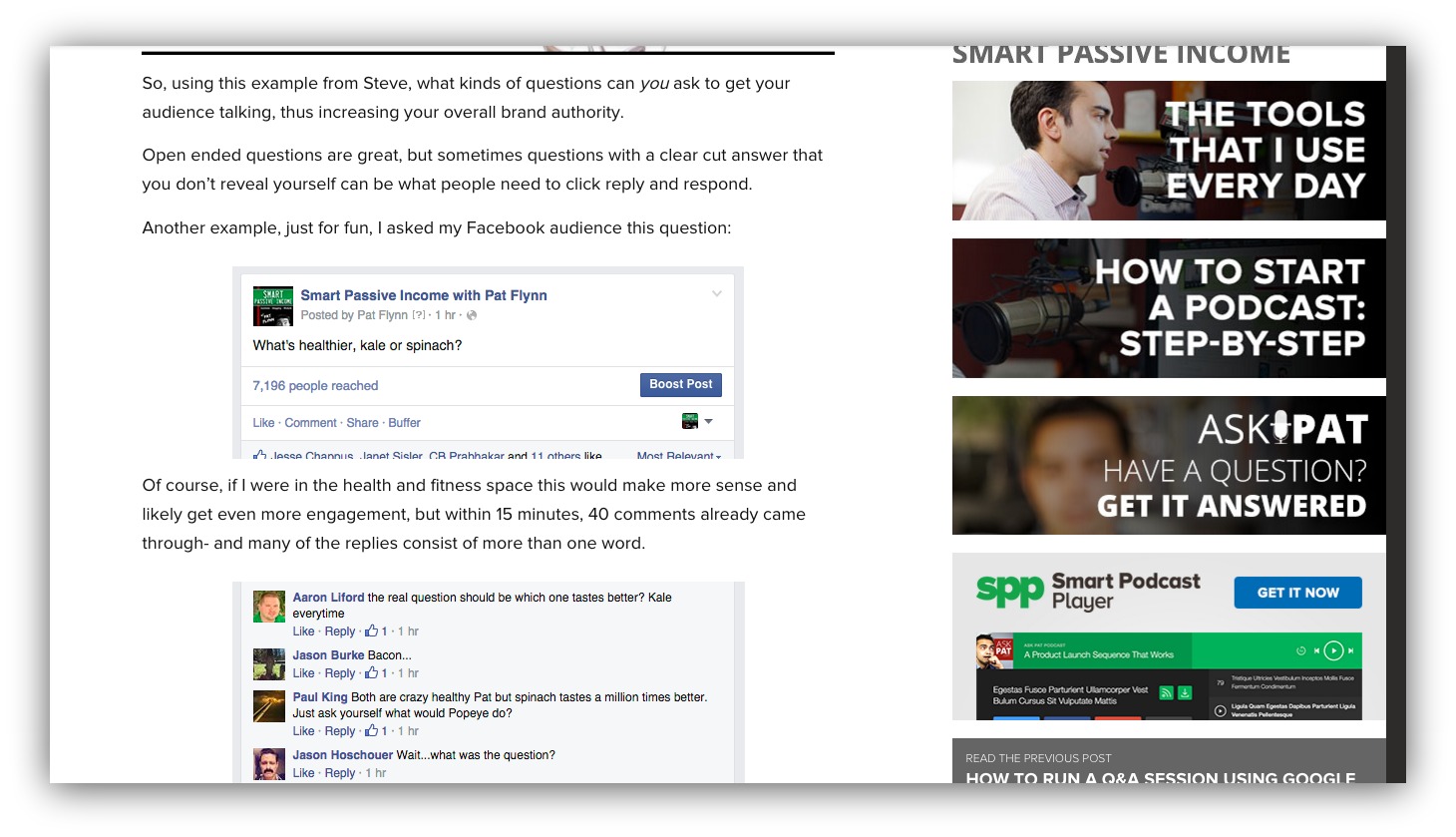
These types of questions are easy to answer and can spark some lively debate.
If you can, ask these questions related to your niche and watch your engagement skyrocket.
When and How Often to Post
Now that you know what to post, you don’t want to post that content at the wrong time.
Maximize the amount of impact your posts will make so you don’t waste your time and energy.
Here are some tips.
Don’t Post at High-Traffic Times
Posting at peak times will hurt your organic reach.
At first glance, that seems counterintuitive. But it makes sense if you think about it. Peak times on Facebook means that’s when everybody is posting, so you’re competing with posts from friends, groups, and pages.
So when should you post to maximize engagement? CoSchedule created a great graphic to answer that question:
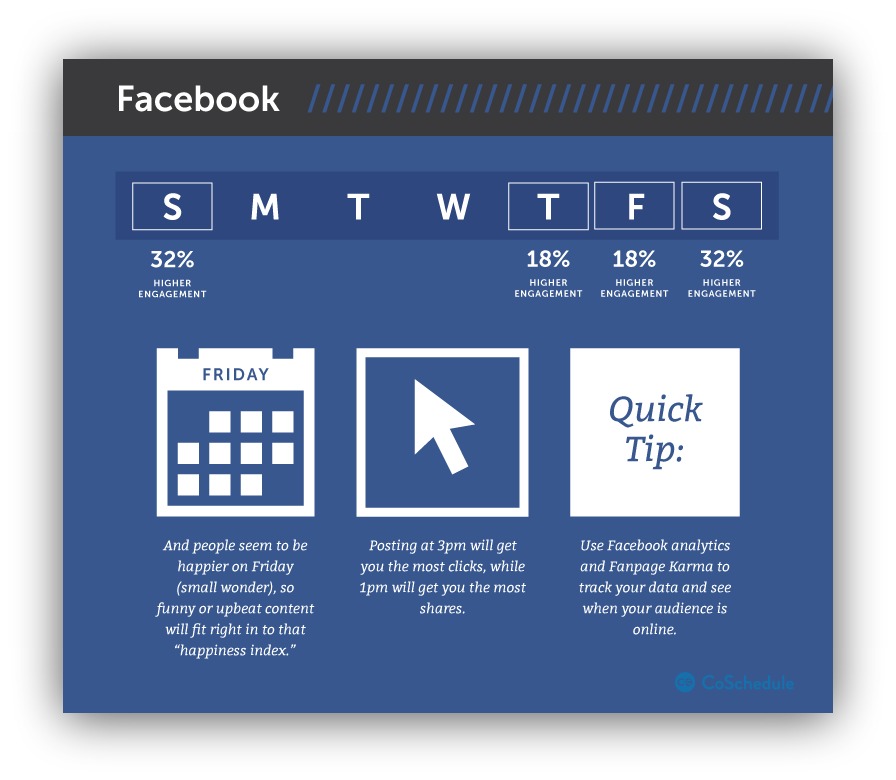
Don’t just blindly follow this, though. The real answer for your Facebook page will depend on industry, your target audience and other factors.
Test out different posting times to see when you get the most engagement. You can find your analytics under the “Insights” tab at the top of your Facebook page:
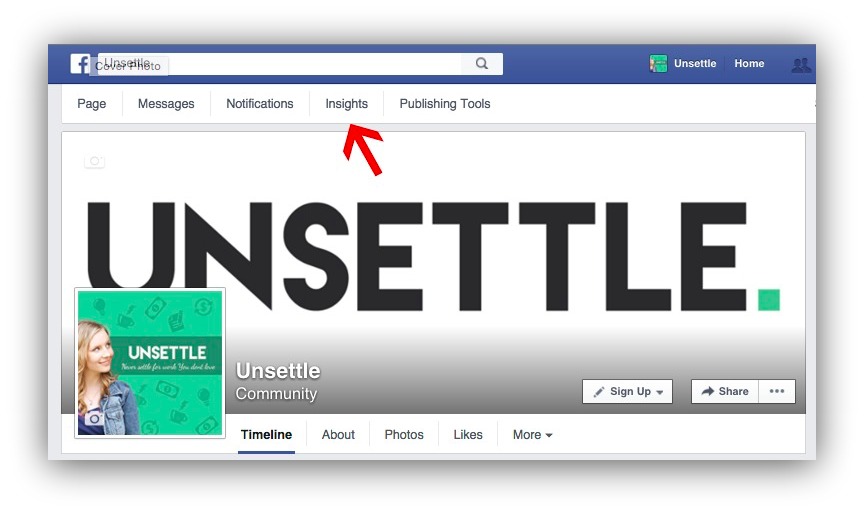
And don’t worry about posting too much while you’re testing. Turns out more can be better with Facebook posts.
Post More Frequently
You don’t want to piss off your Facebook fans off, right?
So to think of posting more than once or twice a day is a bit daunting. But, as Dennis Yu from Social Fresh says, you’ll only irritate your fans by posting too much “if you’re irritating”.
Social Fresh actually reported a downward trend frequency of posting vs. negative feedback:

Though Socialbakers differentiates between media companies and brands, stating that media companies can post far more than brands, with brands posting on average one post per day, and media companies pushing seven:
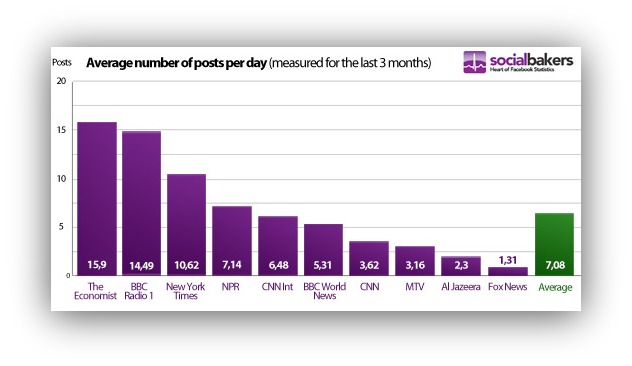
If you post content, there’s no reason you can’t test a higher frequency than one per day. The key if, of course, posting highly useful, engaging, or inspiring content that elicits an emotion.
After you determine exactly when to post your content, make sure you’re optimizing your Facebook page to get those visitors back to your website. Do this by maximizing your calls to action.
Maximize Your Calls to Action
On Facebook, you get a few specific opportunities for calls to action. These opportunities provide prime real estate for people engaging with your page and moving from your page to your website. Don’t waste them!
Harness these opportunities to increase that traffic.
Use That Call to Action Button
One often overlooked method of driving traffic from your Facebook page is the call to action button.
When people land on your Facebook page, they see a series of buttons at the bottom of your cover image. These buttons are in a prominent spot, and one of them is your call to action button.
Don’t forget to set that button up so people are directed to your website when they click it. An example of a page that does this well is Dollar Shave Club:
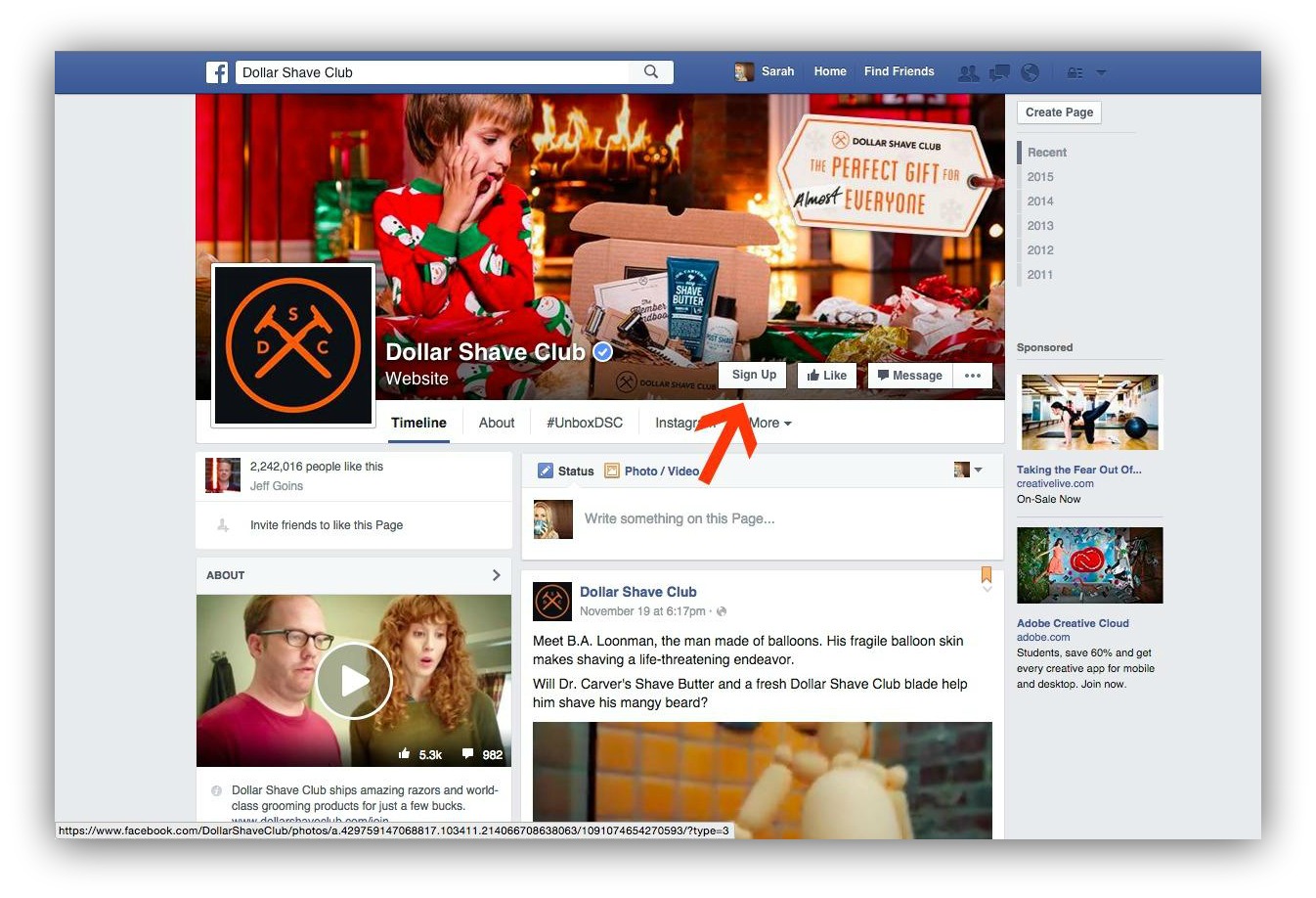
When you click the call to action button, you’re taken to their landing page for signing up for their service:
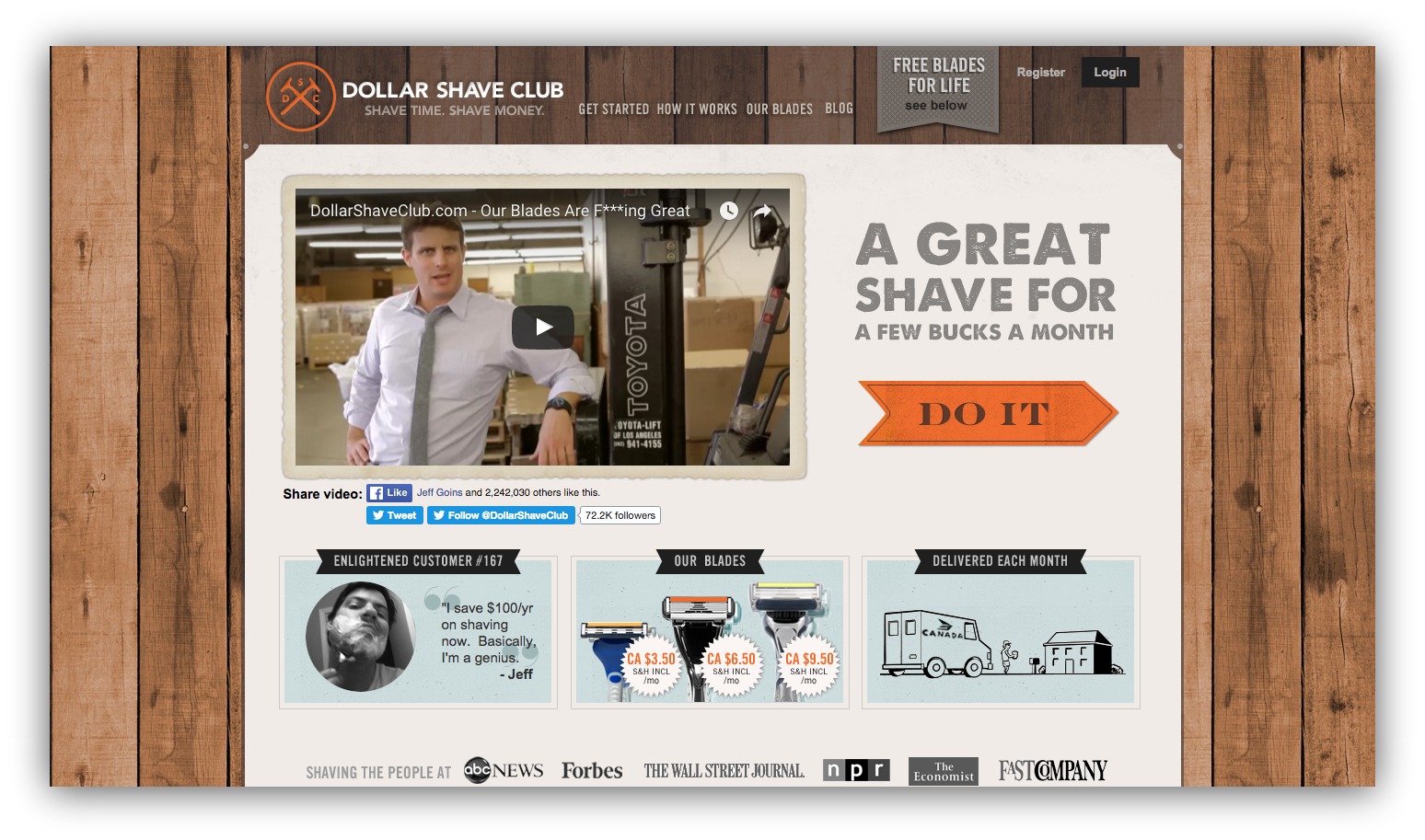
Another thing that Dollar Shave Club does right with their call to action button is that their cover image creates sight lines directly to the button:
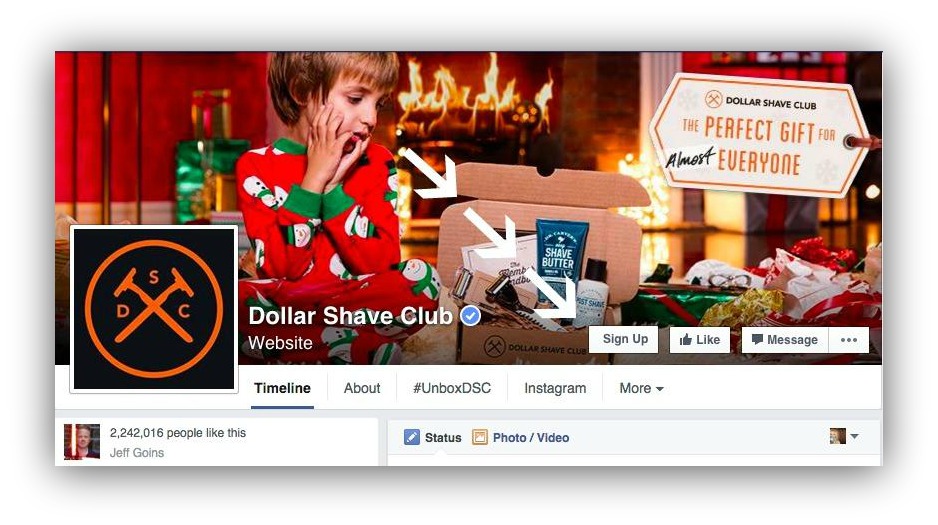
Either their marketing team is smart, or they had a lucky accident, because “line of sight” increases conversions like crazy.
Your Facebook Page Cover Photo
Just like the group image for your Facebook group, your cover photo for your page is the perfect place to include a call to action to drive traffic back to your website.
Include some text over your cover image to call the page visitors to go to your website. You can drive them to a specific piece of content or a compelling freebie, like Danielle LaPorte does:
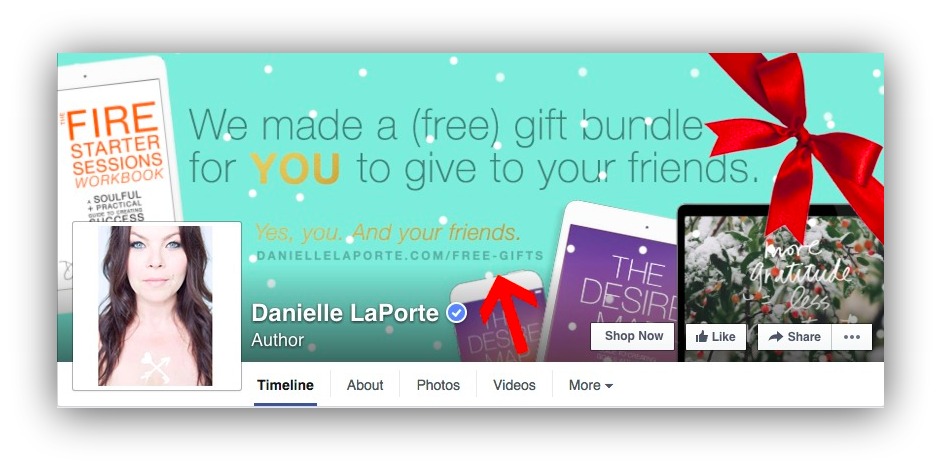
The cover photo is one of the first things visitors to your page notice. Why not take advantage of that attention?
Use Social Proof
Research shows that when your image is shown next to that of a famous person, you’re automatically rated as “more famous”.
The researchers from York College who conducted this experiment call this the “false fame effect” but we like to call it another form of “social proof”.
You already know that social proof boosts your perceived authority, and increasing the cred of your Facebook page is the perfect place to use it.
Have you ever interviewed an influencer in your content? If so, include their photo in your Facebook post about it, like Foundr does with guests:

If an influencer has ever mentioned you in their content, on or off Facebook, repost it with a message thanking them for the mention. When your target audience lands on your Facebook page, they’ll see that you’re legit from that social proof.
Strategy #6: Push Traffic by Reviving Your Archives
Let me guess…
You work hard on a piece of content, share it on social media when it goes live, and then forget about it. The piece of content you worked so hard on gets pushed down to your archives the second you press “publish” on another piece, which goes through the same cycle of content abuse.
Instead of letting your content wither in your archives, drive traffic back to it on Facebook.
Post evergreen content to your Facebook page or group regularly, like Mixergy did with this interview from April, 2015:
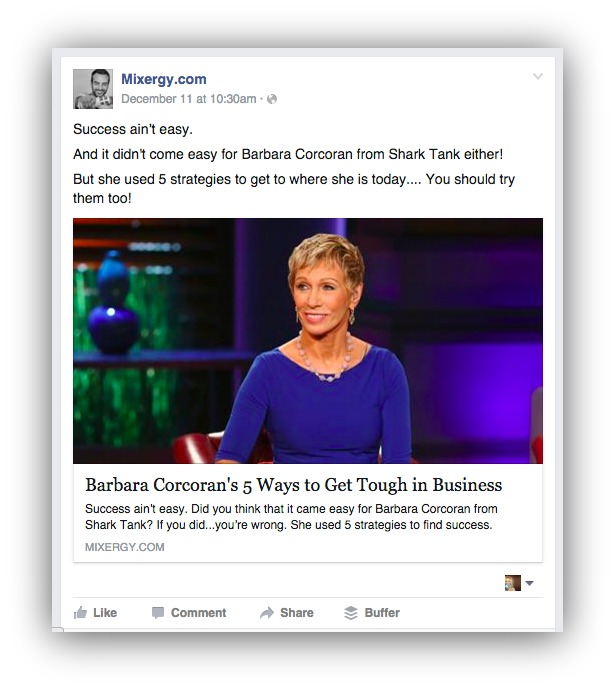
Old content deserves some love, too!
Here’s how to make sure your old content gets plenty of new eyes.
Test Different Types of Facebook Posts with Buffer
Testing is absolutely necessary to maximize your traffic. There are a lot of theories about what content does best on Facebook but you never know what will work with your audience until you test it for yourself.
So use a tool like Buffer with content from your archives to send out several different types of Facebook posts about that content.
Try video, a plain link, longform, images, and any other type of content you feel like testing, and after the content has had time to marinate and get the attention it will get, check the “analytics” tab:
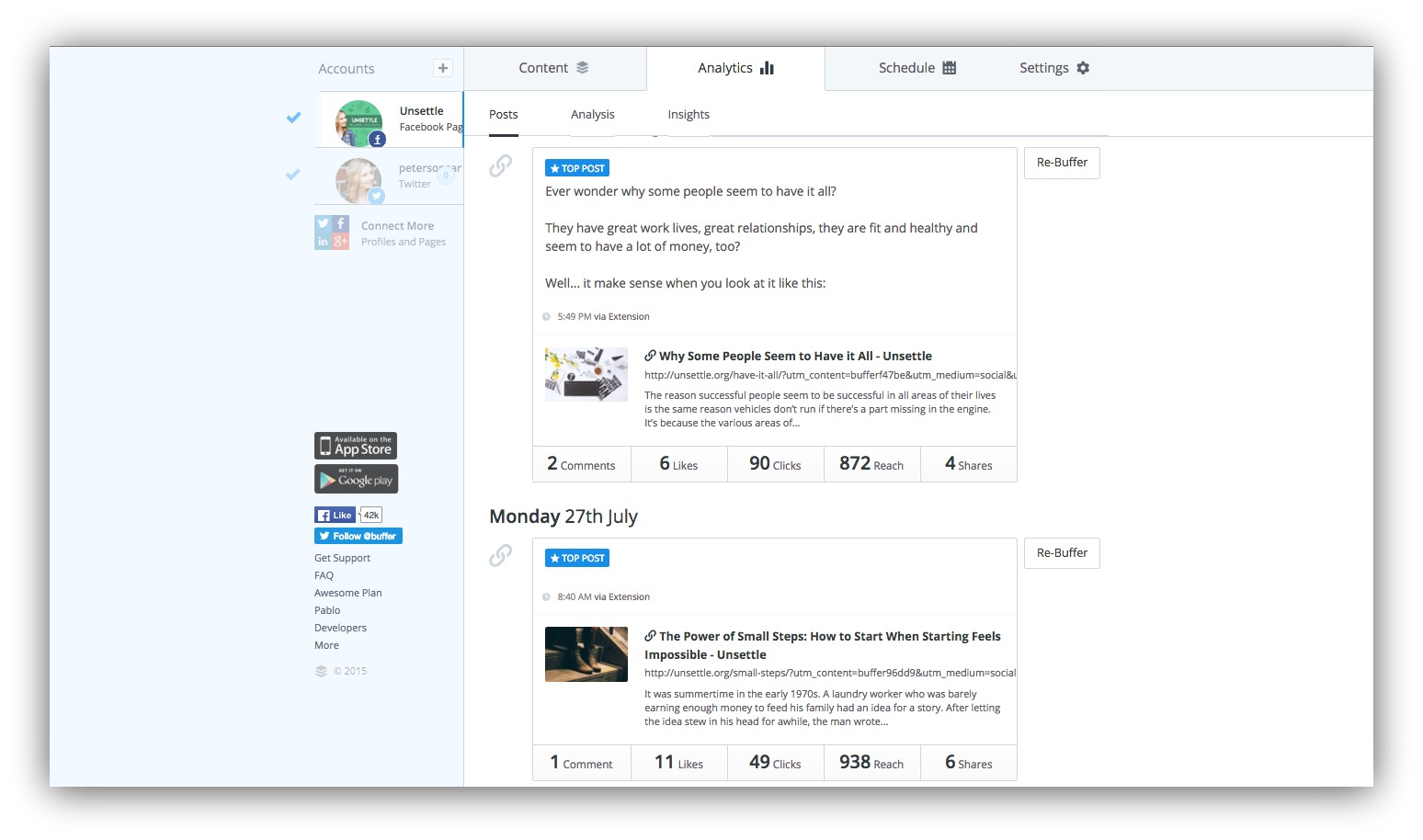
Buffer will tell you which posts did best, which you can then plug into a sharing pipeline so you can set it and forget it.
Use Edgar to Establish a Pipeline of Posts
If you’ve ever become overwhelmed by the sheer volume of old established content that you have published in the past, you’re not alone. Now we’re telling you that you have to go through all that content and share it?!
Don’t worry, though. You don’t have to do it manually.
After you’ve tested the different types of content with your audience using Buffer, find the posts that performed the best on Facebook and use a tool like Edgar to schedule a queue of those posts based on a pre-set schedule you’ve established:
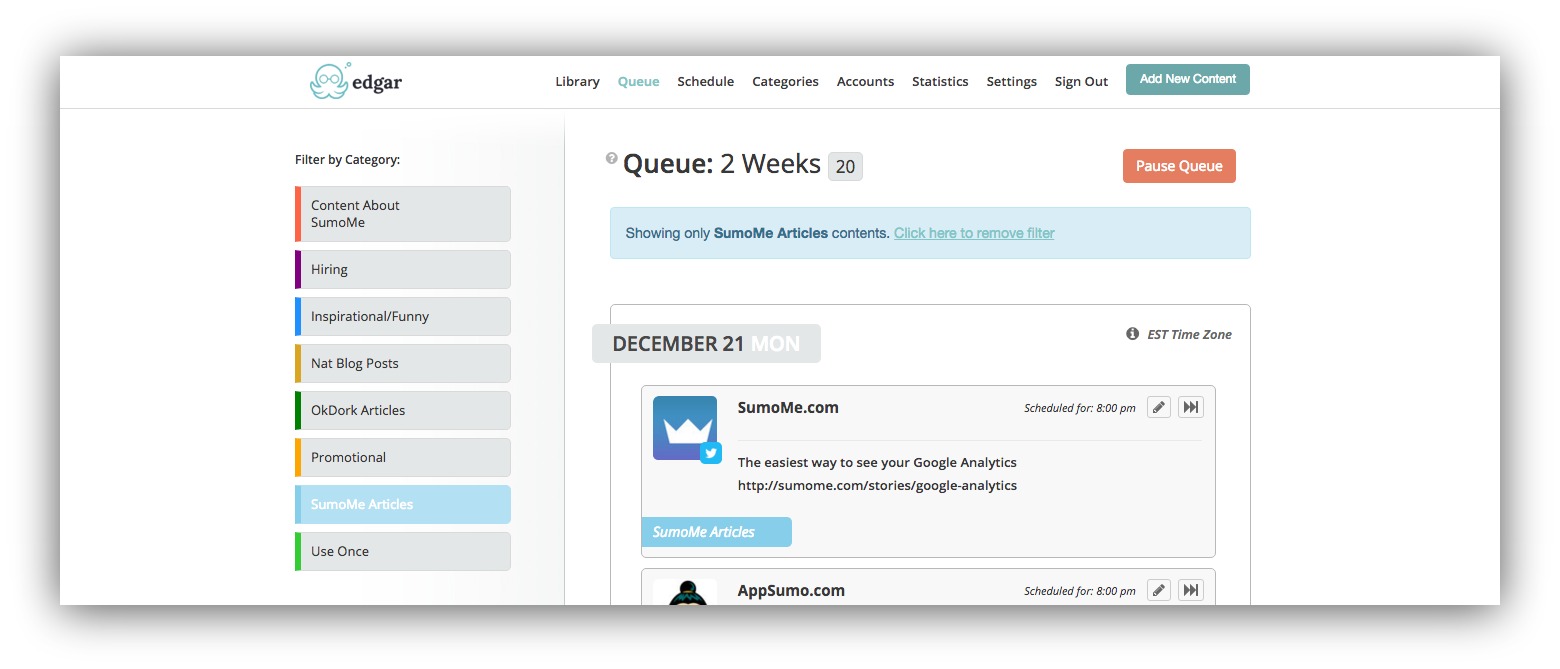
The best part about a tool like Edgar is that you never run out of posts and your content is never forgotten about, because it will be blasted out again on social media once the queue restarts.
Use the post timing guidelines I addressed above to set a schedule for Edgar and let him do his magic.
Strategy #7: Optimize Your Personal Facebook Profile for Traffic
I’ve shown you how to increase your fans, drive traffic from your Facebook page, build and drive traffic from a Facebook group, leverage existing groups, and optimize your existing content for maximum social shares.
Now it’s time to discuss your personal Facebook profile.
I’ve already shown you how to get your Facebook friends to like your page, but there’s much more you can do to use your personal profile as an advantage.
Before you can harness the power of these traffic generating machines, though, you have to do one thing...
Make your profile public.
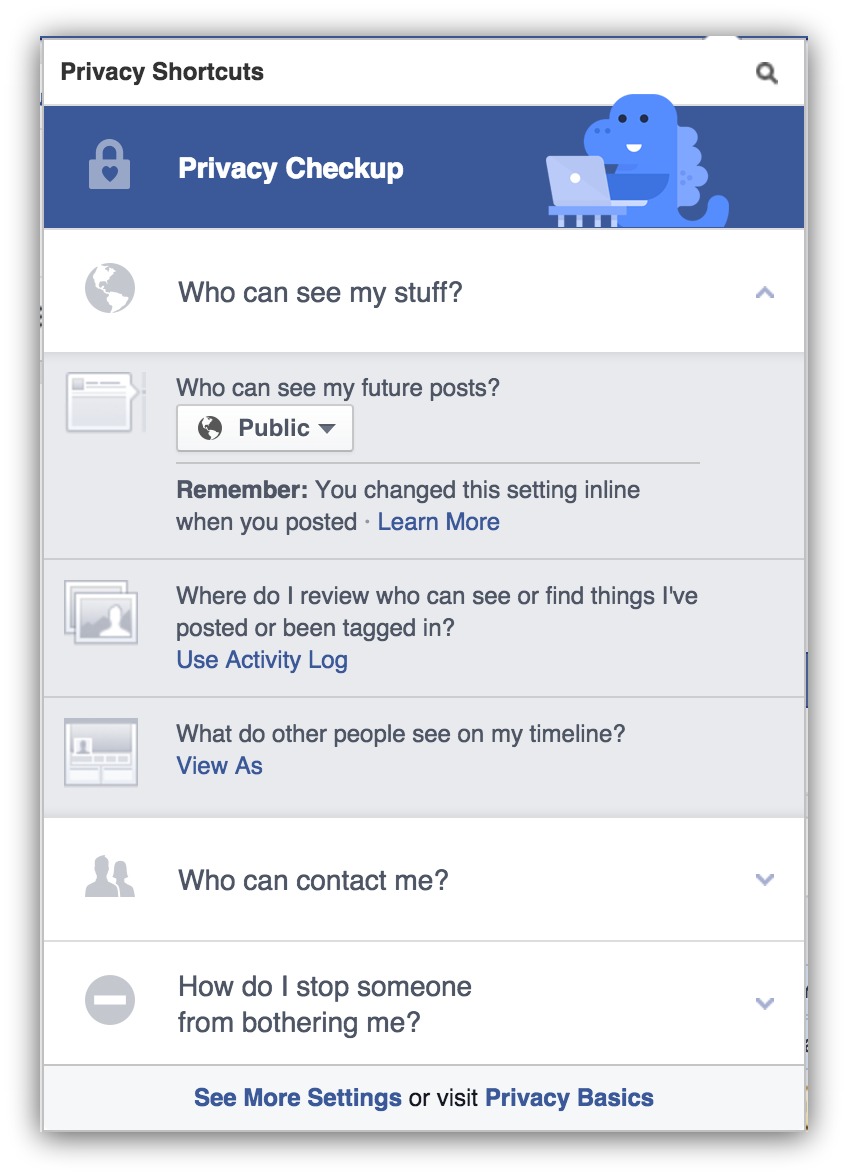
I know, I know. Scary, right? What if somebody steals that picture of your kid you just posted for an ad? Doesn’t Facebook own the rights to everything you post?
Don’t buy too much into the fearmongering. If you’re concerned, just make your previous posts private and open up the rest of your profile to the public. These methods won’t be as effective if you remain private.
So now, let’s start with the most obvious way of getting traffic from your personal profile.
Post Your Content to Your Timeline
When you create a piece of content, in addition to making it super shareable and posting it to your Facebook page and groups, you should also post it to your own timeline.
This allows your friends to see your content, even if it’s not showing up in their newsfeeds from your page.
If you’re going to do this, tag relevant friends in your post who would enjoy the content so it shows up on their timeline.
That way you can leverage their network, as well - and often this will show up in their friend’s newsfeeds.
Use an Author Tag
If you’re in the habit of publishing content and sharing it on Facebook, you might as well leverage other people’s shares as well by using author tags on your website so that when your content is shared, it’s clear who created it.
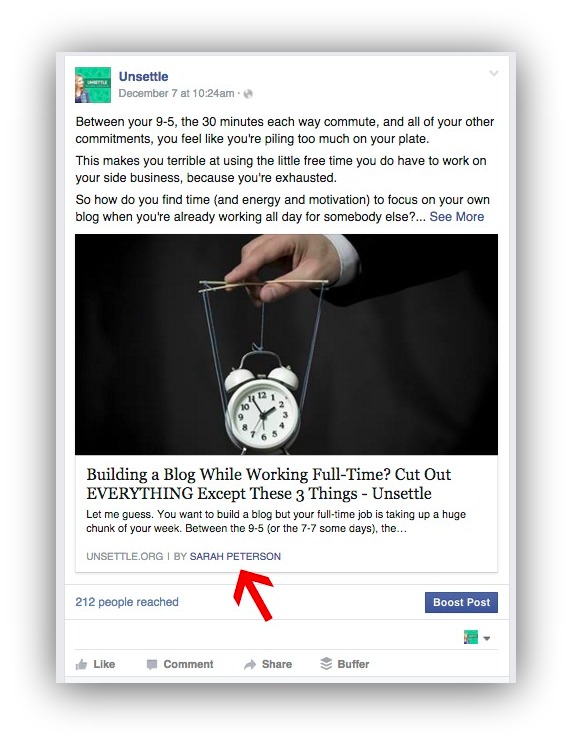
Not only does this create a layer of social proof like we just talked about, but link also expands to allow people to follow your personal profile:

Which allows people to see the content you’re posting to the public. If somebody liked one of your posts, they might like a lot more, so they can just click on your name to find a treasure trove of awesome content from you.
You can enable an author tag either by adding Open Graph Object code to your tag on your website, or just by using WordPress SEO by Yoast and adding the link to your Facebook profile to Users > Your Profile:

Press save and voila! You’re Facebook official.
Make Some Friends
While I know your Facebook profile is a sacred place for stalking old high school frenemies and ultrasound pics from people you haven’t seen or talked to in 10 years, it’s time to loosen up the reigns a bit on whose friend requests you’ll accept.
The more friends you have, the more eyes your content will reach, and the more traffic your website will see.
Jeff Goins is Facebook friends with fans and influencers alike, giving the content he posts to his timeline a fighting chance in the news feed:
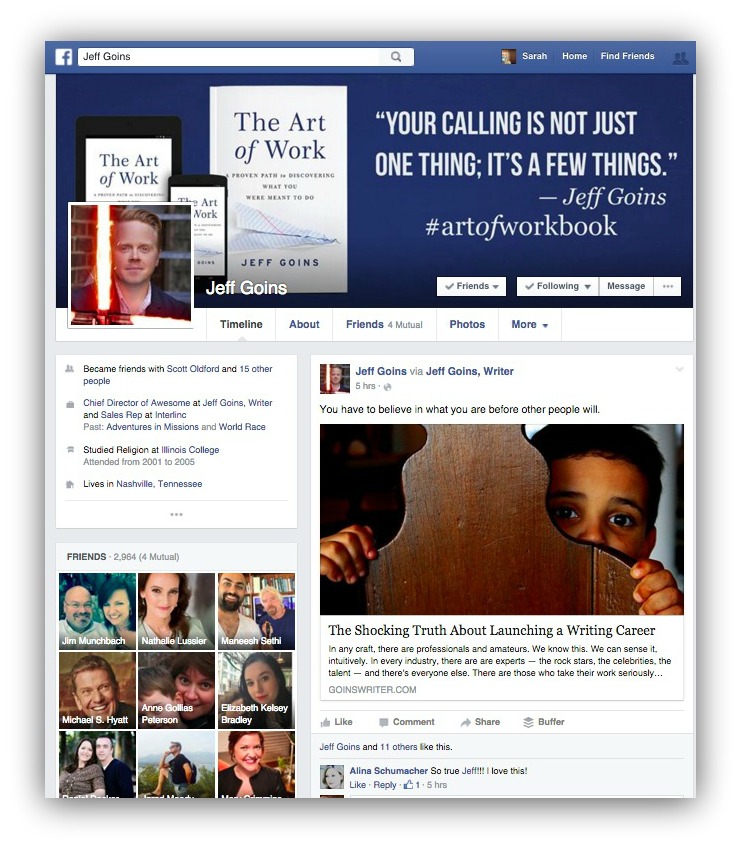
Facebook gives preferential treatment in the news feed for content from friends rather than pages, so becoming Facebook friends with your fans will ensure they actually see that content you’re posting.
Your personal Facebook profile has a lot of low-hanging fruit for traffic. Don’t overlook it’s power.
Stop Ignoring Facebook
Not trying Facebook out for size is like being gifted a lottery ticket and letting it sit on your counter unscratched.
You’re potentially ignoring a jackpot of traffic for your website.
I just gave you a few undeniable reasons why Facebook shouldn’t be ignored and showed you several ways you can use Facebook to drive valuable traffic to your website, potentially helping that traffic drought you’ve been experiencing.
I even created a checklist to help you through all of these tactics to make it even easier on you:
Click here for our Facebook traffic checklist!
And the best part is, there are no excuses: most of these tactics are even free.
Choose one of these options and begin to put it into practice. Start with the lowest hanging fruit and track the results with Sumo’s Share App.
End the drought and make it rain traffic on your website with Facebook.


Comments